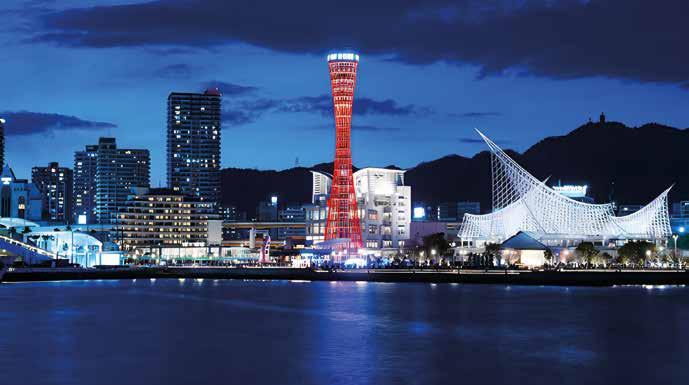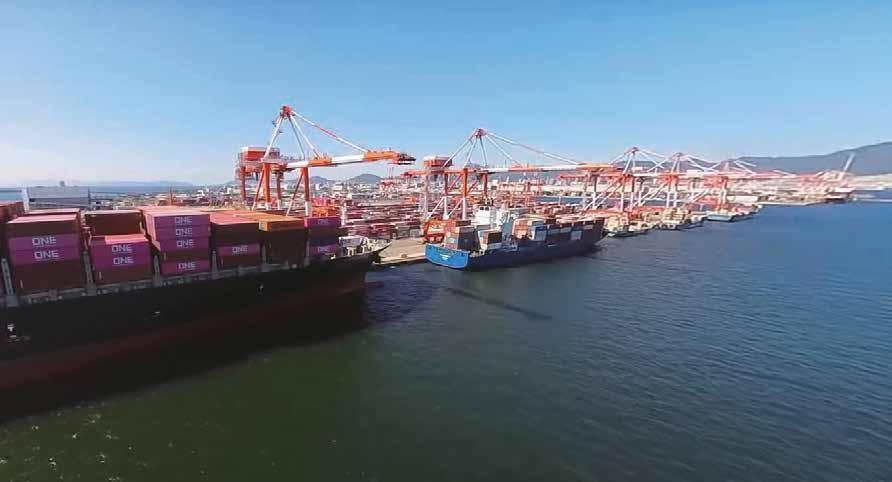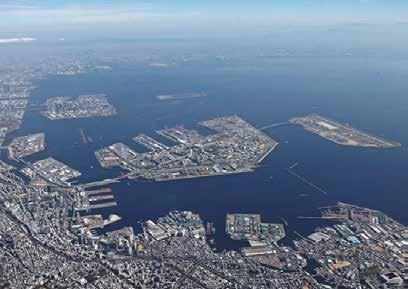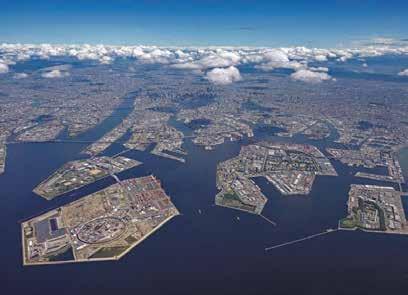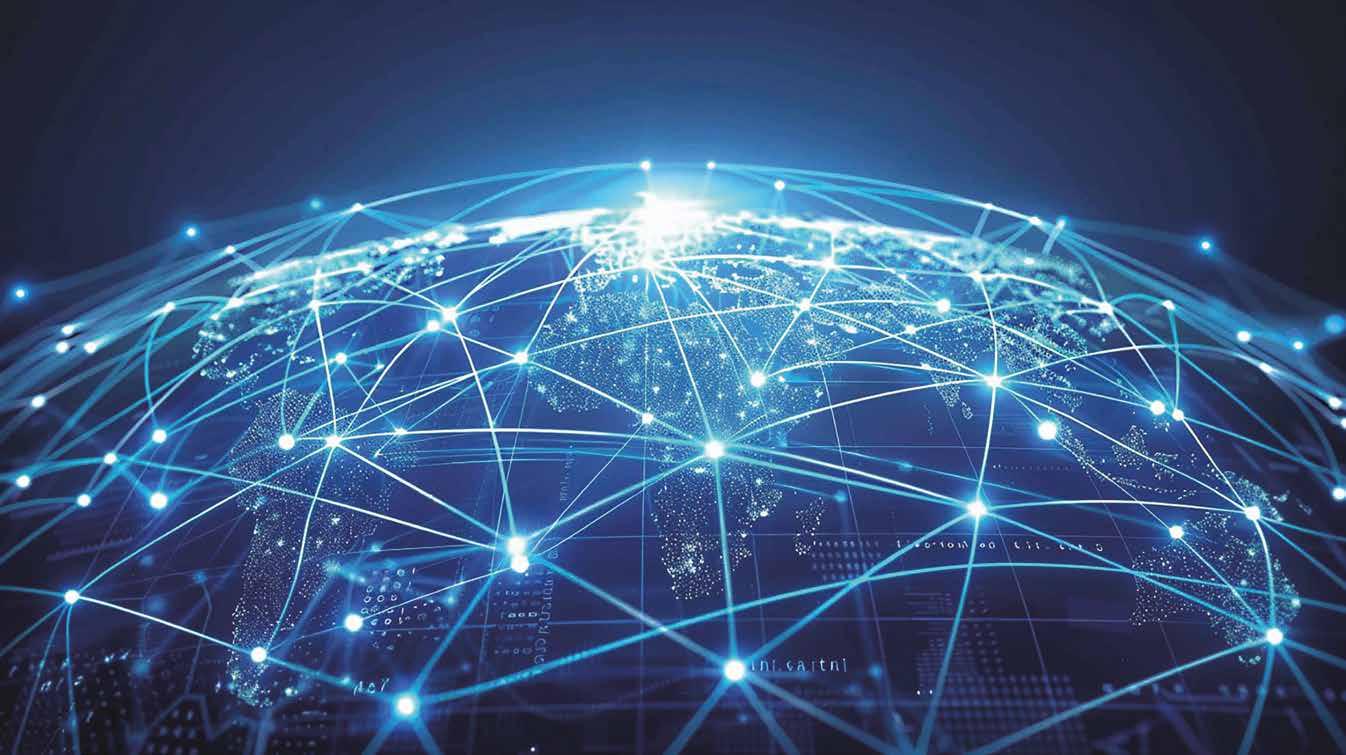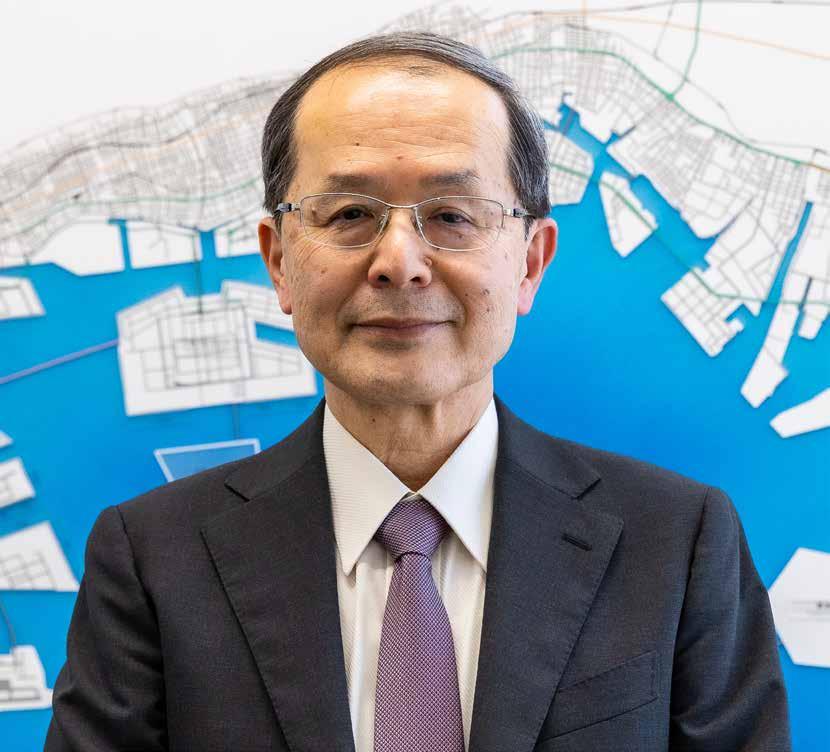

Countdown to Kobe
Masaharu Shinohara of Kobe-Osaka International Port Corporation says the upcoming World Ports Conference is a timely reminder of the values that established IAPH

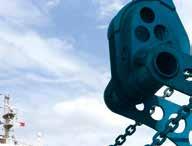
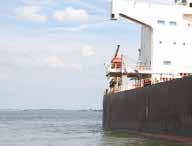
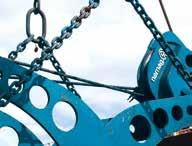
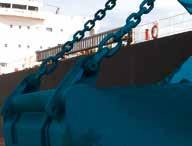
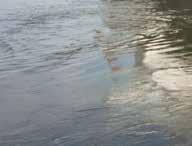
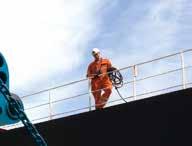
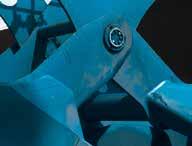
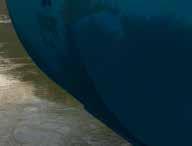

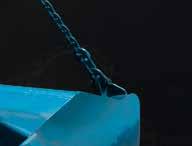
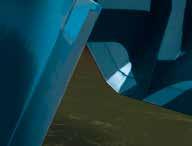
\ T HE P OWE R OF GREAT BULK H ANDLING




Reduced handling costs, shor ter turnaround times, reliability and flexibility: Nemag grabs give dry bulk terminals throughout the world that competitive edge they need in today’s demanding market.
Driven to achieve the best performance, we closely listen to our clients’ needs. For almost a hundred years, Nemag’s innovative grabs make it possible to realize the highest productivity at the lowest costs.
Explore our comprehensive range of high-quality grabs and discover the power of great bulk handling.
From coal and iron ore to wheat, scrap metals, minerals and clinker: Nemag has the optimal solution for every dry bulk flow!
Contact us find out how we can take your bulk handling to the next level.






































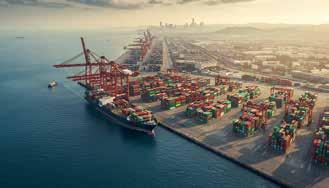
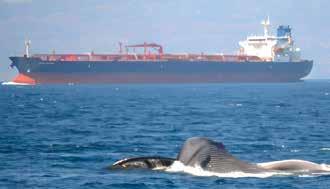
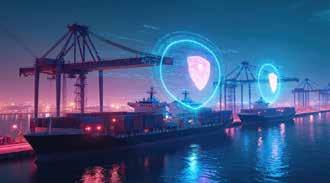
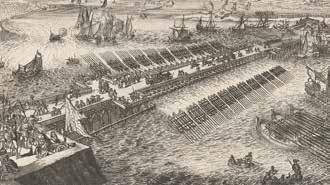

Providing thought leadership on the role of ports in a connected world
EDITORIAL & CONTENT
Editor: Martin Clark editor@ports-and-harbors.com
Features Editor: Felicity Landon
Publisher
Dr. Masahiko Furuichi
IAPH Secretary General info@iaphworldports.org
Dr. Patrick Verhoeven
IAPH Managing Director patrick.verhoeven@iaphworldports.org
Regular Correspondents: AJ Keyes, Mike Mundy, Vladislav Vorotnikov
Production
David Blake, Paul Dunnington production@mercatormedia.com
SALES & MARKETING
t +44 1329 825335 f +44 1329 550192 Marketing marketing@mercatormedia.com
Chief Executive: Andrew Webster awebster@mercatormedia.com
Ports & Harbor magazine is produced and edited bi-monthly by Mercator Media Limited, Spinnaker House, Waterside Gardens, Fareham, Hants PO16 8SD UK t +44 1329 825335 f +44 1329 550192 info@mercatormedia.com www.mercatormedia.com
Subscriptions
INTERNATIONAL ASSOCIATION OF PORTS AND HARBORS
IAPH members enjoy a free subscription to P&H. If your organisation is not a member and you would like a paying subscription to the magazine, please contact the IAPH for more information at: 7th Floor, South Tower, New Pier Takeshiba 1-16-1 Kaigan, Minato-ku Tokyo 105-0022, Japan
T: +81 (0) 3-5403-2770
F: +81 (0) 3-5403-7651
E: ph@iaphworldports.org
W: www.iaphworldports.org
©Mercator Media Limited 2025. ISSN 1740-2638 (print) ISSN 2633-4232 (online).
Ports & Harbor is a trade mark of Mercator Media Ltd. All rights reserved. No part of this magazine can be reproduced without the written consent of Mercator Media Ltd. Registered in England Company Number 2427909. Registered office: c/o Spinnaker House, Waterside Gardens, Fareham, Hampshire, PO16 8SD, UK.

EDITOR’S COMMENT

MARTIN CLARK Editor
Charting a new course I
n every era of maritime history, ports have stood as powerful reflections of the world around them — changing tides, changing trades and changing technology. Today, ports are no longer just gateways for goods. They are becoming dynamic laboratories of innovation, sustainability and transformation. As the global maritime sector accelerates into a new age of automation, digitisation and decarbonisation, the identity of the modern port is undergoing a profound shift. This issue of Ports & Harbors magazine explores how the world’s ports are embracing this evolution — but not just adapting to change, actively shaping it.
Digital twins, AI-based cargo tracking, drone inspections and smart berth management are no longer buzzwords; they’re becoming operational reality. Ports are
CONTRIBUTORS

KEVIN GODIER Freelance journalist
Kevin Godier is an independent journalist and the editor of International Trade Finance, the journal of record for trade finance markets, now publishing for more than four decades. He is among the leading commentators on the rise of non-dollarised global trade and a keen observer of current geopolitical trends. ■
embedding intelligence into their infrastructure, turning data into insight, and insight into competitive advantage. These tools are helping terminal operators anticipate congestion, reduce emissions and streamline throughput in ways that were unthinkable even just a decade ago.
Inside, we include details of recent IAPH publications and initiatives, including the release of the new World Ports Tracker, which outlines major trends and shifts taking place across the industry. There is also an article explaining how cybersecurity is emerging as a priority given the emergence of new technologies and greater connectivity between ports and the broader maritime sector. It follows the release of guidelines on how ports can not only protect against these cyber threats and challenges, but also capitalise on potential opportunities.
Alongside this technological revolution, another equally pressing challenge arises: climate change and climate resilience. Rising sea levels, extreme weather events and carbon regulation are pushing ports to take bold steps toward environmental leadership. Whether it’s through green energy hubs, electrified equipment, or shoreline restoration projects, ports are finding new ways to safeguard both operations and ecosystems.
This work is urgent — but it is also inspiring. Inside this issue, you can read about how ports are working with other partners to protect whales and other wildlife. We also highlight the incredible success of the IAPH World Ports Sustainability Program (WPSP), featuring an interview with Antonis Michail, the initiative’s technical director.
A key part of WPSP is the annual Sustainability Awards, a showcase for innovation, which this year attracted a record number of entries. Perhaps it reflects a common purpose

among world ports to be ready for the future, not just react to it — and to lead by example, in areas ranging from climate and energy and environmental care through to community building and digitalisation.
Amidst the waves of time, one thing remains constant: people. From dockworkers and data scientists to engineers and environmental planners, the human element remains at the core of the success of all of these projects. It is the people that ensure the success of the world’s ports in the face of such sweeping and often turbulent change.
Our View From Astern article, written by IAPH managing director, Patrick Verhoeven, highlights the changing fortunes of Antwerp through the centuries, offering us further reflection on how current turbulence is not without precedent, and that ports have shown their ability to adapt and even endure when called for. This resilience and these abilities have not been left behind in the annals of history.
As we move through 2025, and beyond, ports must balance agility with accountability, growth with green goals, and innovation with inclusion. These are all significant challenges. IAPH, which this year marks its 70th anniversary after being formed in the years following World War Two, has already sailed through decades of change and uncertainty. It is the safe harbour for ports around the world. The IAPH 2025 World Ports Conference, which takes place in Kobe, Japan on 7 to 9 October, is the central gathering point for this community, an unmissable opportunity to connect with, and to learn from, peers as the industry braces for the winds of change once more. ■ Get in touch: editor@ports-and-harbors.com

AJ KEYES
journalist
FELICITY LANDON Freelance
Felicity Landon is a journalist and features editor on P&H.
A well-known figure in maritime circles, with the depth of knowledge and network of contacts to prove it, Felicity is versatile in her areas of coverage from container, dry and liquid bulk to energy and other areas. ■
Freelance journalist
AJ Keyes is a highly experienced writer and journalist following shipping and port activities on a global basis. He has a long-standing interest, and specialises in, the North American maritime industry, which he covers in this issue with a focus on Transpacific trade routes. ■
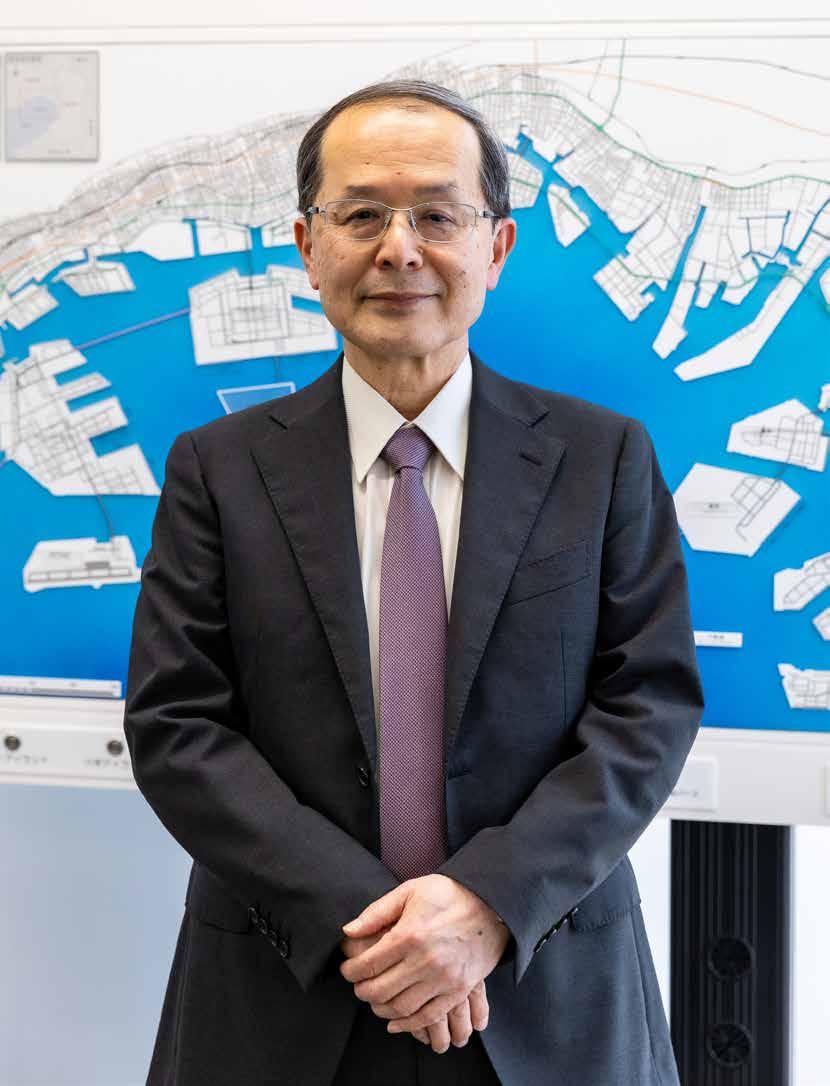
IN CONVERSATION WITH MASAHARU SHINOHARA
An invitation to Kobe
Masaharu Shinohara is Executive Officer of Kobe-Osaka International Port Corporation and serves as IAPH vice president for Asia (South/West, East and Middle East). Here, he talks with Patrick Verhoeven about the upcoming IAPH World Ports Conference, to be held in Kobe in October, and how it brings a timely reminder of the core values that helped establish IAPH some 70 years ago
MARTIN CLARK
QMasaharu (M), can you give us a brief introduction to yourself and your work?
M: For 31 years after graduation, I worked for Japan’s Ministry of Land, Infrastructure, Transport and Tourism (MLIT). My work at the Ministry included planning, design and construction of ports and airports, analysis of container shipping, land use planning, tourism development, and space development such as rockets and satellites. After quitting the government job in 2009, I was employed by Osaka Port Corporation, which five years later merged with Kobe Port Corporation, thus forming Kobe-Osaka International Port Corporation. As Executive Officer of this merged company, I am responsible for the analysis of container cargo movement to and from Japan, and the development of technologies such as artificial intelligence (AI) and drones and how they are applicable to container terminal operations.
Q: Can you tell us about your IAPH role?
M: My first participation in IAPH activities was at the Busan World Ports Conference in 2011, a valuable, informative and exciting event, where I learned a lot about what’s going on in other countries. Soon after this, I got involved in the IAPH technical committee activities as chair of the port operations & logistics committee. In 2016, after the reorganisation of IAPH, I was elected as vice president for Asia, South/West, East & Middle East. This region — called Asia-1 region in short — is so widespread area-wise, and extremely diverse in its history, politics, and culture.
Q: What would you say are your priorities right now given such a huge geographical area?
M: I must admit it’s nearly impossible and impractical to cover the whole region with the same intensity and interest. Right now, I am focusing on East Asia, including China, Korea, and Japan. Japan has 24 regular members, China 11, and Korea seven. However, the members from these three countries are not so proactively involved in IAPH activities. So, my first priority is to liven up and encourage more participation among the East Asian members. In this context, IAPH Japan Foundation and IAPH Japan Association jointly hold the IAPH Japan Seminar every year to disseminate IAPH products and materials and encourage further participation. We recently held a joint seminar with Korea Maritime Institute in Busan on IAPH initiatives for port decarbonisation.
Fortunately, we also have an IAPH representative in India who is doing a marvellous job there. Perhaps we also need a separate IAPH representative based in the Middle East.
Q: This year marks the 70th anniversary of IAPH, culminating with the Kobe conference in October. What is the significance of hosting this event in Japan?
M: IAPH was born in 1955 in Los Angeles. Three years before, in 1952, Kobe hosted the first world ports conference, where they made the historic resolution of founding the IAPH. This was led by Mr. Gaku Matsumoto, Chairman of The Ports and Harbours Association of Japan. He envisaged this bold and revolutionary idea of establishing a world organisation of port authorities
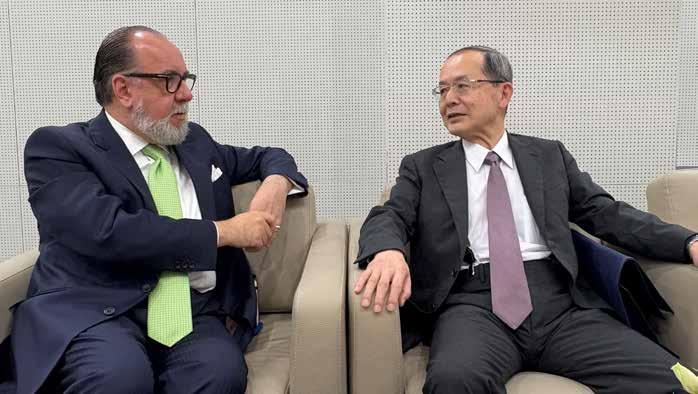
around 1950. We should remember that Japan lost the Second World War in 1945, and was under the control of the Allied Forces until 1952. Mr. Matsumoto’s idea of establishing a new global port organisation was mostly brushed aside by foreign port leaders because they thought Japan, as a defeated country, should not take the leading role in this process. Despite several opposing port leaders, he tenaciously explained its importance and persuaded them to finally approve the founding of IAPH at the Kobe conference in 1952. In this context, I am extremely excited and pleased to have the 70th anniversary of IAPH here in Kobe, my hometown. Moreover, it is also a reminder of the spirit behind our foundation following the war. It was a time when global trade came back as a primary goal of the world, and IAPH stepped into that space, that philosophy of world peace through world trade, which of course depends on the world’s ports.
Q: Patrick (P), is that a theme you are keen to highlight given world volatility in 2025?
P: Yes, it is worth remembering we were founded on the idea of facilitating global trade, and that is still, I think, what the port industry wants, and what the shipping industry wants. If we compare that era and spirit of cooperation in the 1950s with the current landscape, things seem to be going in the reverse direction again. It seems global trade is under pressure once more because of geopolitical tensions, trade wars and armed conflicts as well. We are keen as an international port organisation to go back to that philosophy of world peace and world trade going hand in hand, so, in that sense, it's timely that we commemorate why we were founded 70 years ago by returning to Kobe.
I am extremely excited and pleased to have the 70th anniversary of IAPH here in Kobe, my hometown ‘‘
MASAHARU SHINOHARA, Executive Officer, Kobe-Osaka International Port Corporation
Q: What are the main trends shaping Japan’s port industry today?
M: There are two dynamic trends: one is decarbonisation, and the other is the introduction of AI-assisted container terminal operation.
On decarbonisation, Kawasaki Heavy Industries and others are experimenting with liquid hydrogen transport from Australia to Kobe. At Kobe conference, a viewing is planned of the hydrogen unloading terminal at Port of Kobe, a world-first, one-of-a-kind, demonstration project. They also built the hydrogen-burning power plant near the unloading station, which is also worthy of attention. Our company has also just successfully launched the world’s first RTG equipped with a hydrogen-fuelled internal combustion engine at Port of Kobe, which is expected to help with port decarbonisation.
As for the introduction of AI and other advanced technologies, MLIT has been focusing on assisting port-related companies’ R&D efforts in order to make Japanese container terminal operations competitive and compatible with
Pictured: Masaharu Shinohara with Patrick Verhoeven at a recent industry event in Seoul, South Korea

advanced terminals overseas. For example, MLIT and our company have now completed the advanced container terminal appointment system utilising smartphones and port security IC cards to alleviate gate congestion. Our company has also been developing a predictive maintenance method for STS cranes utilising AI technologies. Right now, we have successfully completed the proof-of-concept stage, where we can predict STS cranes’ malfunction within 72 hours with 90% accuracy.
That is our philosophy: to make sure we raise the bar for the whole port community ‘‘
PATRICK VERHOEVEN, MD, IAPH
topic we will be addressing at the Kobe conference in a dedicated session in which Masaharu will participate. Likewise, we recognise the general problem of attracting young people to the industry. Perhaps that’s partly to do with the perception, they see ports and maritime as a bit of an oldfashioned industry which is not the case. If you look at all the things happening in our sector, with innovation, technology, and the like, it’s really quite exciting. There is certainly competition for talent so perhaps we need to work harder to show that dynamic side of the industry.
P: This is also what IAPH is about, in terms of sharing knowledge. At the conference in Kobe, people will be able to see the liquefied hydrogen receiving terminal constructed by HySTRA. This exchange of know-how is something we want to promote via our technical committees, but also during an event like the conference, people can learn directly from each other, from the advanced countries and ports. That is really our philosophy: to make sure we raise the bar for the whole community of ports.
Q: It has been over 10 years since the merger of Kobe and Osaka ports. What would you say are the main achievements and successes post-merger, and what are the focus areas going forward?
M: One of the main achievements is that we developed and expanded the container coastal feeder service network between Kobe and Japan’s many local ports. For the past 10 years, the weekly number of feeder service port calls to Kobe has increased from 68 to 89, thus making a modal shift from trucking to coastal shipping, thereby reducing GHG emissions. A key focus for us now is dealing with a chronic shortage of young workers, due to Japan’s ever-lowering fertility rate. This means we have to cope with a shortage of port labourers and truck drivers by increasing the productivity of these workers. Therefore, we need to develop and apply state-of-the-art productivity-enhancing technologies to these labour-intensive sectors.
P: With all the challenges we now face, from decarbonisation to digitalisation, many other ports around the world are looking at alliances or mergers. Key examples include Antwerp-Bruges, HAROPA and Seattle-Tacoma as recent examples. This is a
Q: How have geopolitical tensions this year impacted ports in Japan or East Asia?
M: It’s too early to tell the exact impact of tariff wars between the US and China. I am cautiously optimistic because, in the end, both countries will lose if they stick to imposing extra high tariffs against each other. We shall see what happens. Having said that, I am nervous about the impact of tariffs on automobiles and parts. Japan’s automobile industry is our most important sector, in terms of its large share of total production output and export values. I hope the tariffs against automobiles will be repealed as soon as possible, otherwise, we may be in trouble.
P: At IAPH, we are keen to support our members in all of these regions and to highlight that with these trade barriers you create not only a problem for ports, but for the entire supply chain, which, in the end, will benefit no one. I think history has shown that time and again, so we need to take that message to policy makers. It also comes back to our roots and why we were founded. I recently read the reports from the first two IAPH conferences, in 1952 and 1955, and they were all about reducing barriers, lifting tariffs, smoothing free trade, that was essential back then, and we should not forget that today.
Q: Any final remarks or closing comments for P&H readers?
M: I sincerely wish for many port executives and staff around the world to attend the Kobe conference. It will be a big event as the 70th anniversary and you can also taste great Japanese food and experience the culture. You can also visit Expo 2025 in Osaka, which is open until 13 October. Please come and enjoy Kobe! ■
State of the union
The newly-updated IAPH World Ports Tracker identifies major sustainability and market trends shaping the port sector. FELICITY LANDON examines the annual report’s findings — and what we should make of them
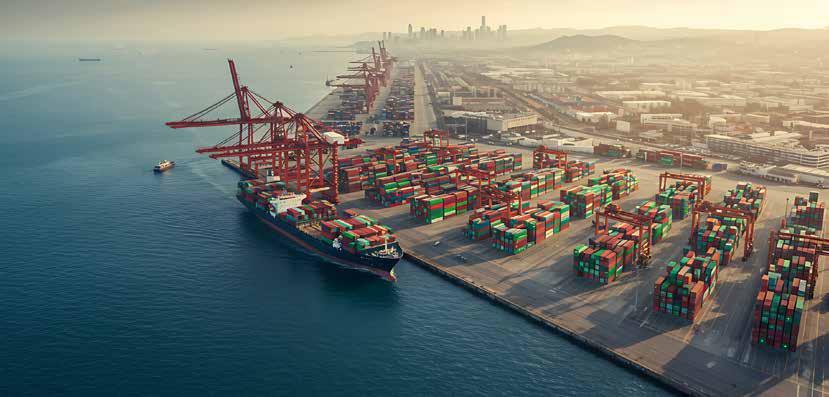
Five years after the IAPH started regular surveys to check in on ports’ progress during the Covid-19 pandemic, those surveys have evolved into a comprehensive, all-angles-covered World Ports Tracker.
Perhaps, says IAPH managing director Patrick Verhoeven, we should call it an ‘annual state of the ports industry’ report. Certainly, analysis of data gathered for the new IAPH World Ports Tracker provides a fascinating insight into the hopes, plans and realities of port operations around the world; it also comes up with some surprises and, naturally, some issues of concern.
Almost half of the IAPH’s member ports participated in a far-reaching survey for the report, covering six areas of interest from the World Ports Sustainability Programme (digitalisation;
community building; climate and energy; health, safety and security; infrastructure; and environmental care) and two other aspects relating to market trends – market outlook and strategic decisions. Their responses were blended with data from S&P Global and LSCI (Liner Shipping Connectivity Index) data from UNCTAD and MDS Transmodal; this vast bank of information was then analysed and presented in a valuable and clear report by Professor Thanos Pallis and Professor Theo Notteboom of the IAPH’s Risk and Resilience technical committee.
Pictured: The IAPH World Ports Tracker provides an essential snapshot of the industry in 2025
Photo: Dreamstime

Evaluation of risk factors for the port area
Geopolitical considerations
These are changing times for ports. Reporting on what’s happening with regards to sustainability, we find a very dynamic situation. Being able to benchmark yourself with your peers is really important ‘‘
Fluid situation
As Patrick Verhoeven said during a webinar to discuss the findings, this may be a totally new format, changing from a quarterly report to an annual one and incorporating new elements, but the IAPH has adopted the ‘never change a
winning team’ approach since 2020, and the expert authors remain the same.
“At the beginning of the pandemic, the IAPH needed a measure of what was going on, so we started producing a weekly barometer – we couldn’t do anything else at the beginning of Covid,” Thanos Pallis told P&H. “It was intensive but interesting, because so much was happening. We then moved on to some fine tuning. Information multiplies with all the means you have to gather it, but you always need to be relevant. If you are not, why are you doing it?”
The Tracker, he adds, is important. “These are changing times for ports. Reporting on what’s happening with regards to sustainability, we find a very dynamic situation. Being able to benchmark yourself with your peers is really important.
KEY TRENDS
● Infrastructure investments: Infrastructure investments in ports progress and remain undeterred. Ports are demonstrating strong performance in carrying out infrastructure investments. Some 69% of ports progressed physical infrastructure projects as planned; 22% experienced only minor delays. Only 8% of ports reported significant delays. Inland infrastructure improvements were even more encouraging, with nine out of ten ports reporting on-schedule execution or only slight delays.
● Sustainability investment: Sustainability-focused investments such as onshore power supply for seagoing and inland vessels, plus renewable energy infrastructure such as solar and wind power, remained consistent with 67% of ports reporting that these projects were progressing according to schedule.
● Container terminals: Container terminals lead when it comes to port expansion plans. About 33% of ports reported that major container terminal capacity expansions or upgrades are expected to become operational in 2025. The figure was 22% in the bulk cargo sector, 13% in cruise terminals and only 7% in non-cruise passenger terminal operations.
● Emissions monitoring: Fifty-eight per cent of ports have declared carbon emissions targets but 29% of ports do not regularly measure their carbon footprint. Ports concentrate most environmental monitoring resources on water and air quality: Four out of five ports monitor water quality and air quality; two-thirds monitor water consumption, noise and carbon footprint. Underwater monitoring is done by only 11% of ports.
● Port digitalisation: Other findings included progress in digitalisation but more effort is required in implementing a Maritime Single Window, Port Community System (PCS) and/ or Just-in-Time in ports; a continued focus on community building; and women’s share of management or board positions is significantly short of the mark in most ports.
● Geopolitical concerns: Geopolitical upheavals, climate change, cyberattacks, pandemics, disasters — these are some of the big risk factors for ports and global trade. The Tracker found significant evidence of ports building resilience against disruptions. Of the ports surveyed, 77% hold regular emergency drills and exercises; the same percentage have developed an emergency management response and coordination framework to address their priority risks, and 68% have implemented a business continuity plan to cope with potential disruptions. More than 81% of the port authorities responding have established procedures for coordinating, collaborating and sharing resources with relevant parties during major incidents.
The report also helps the port industry to understand whether specific changes are actually happening or still at the discussion level. You have the opportunity as a port or terminal to measure yourselves versus your peers – how far have I gone or not gone? That can also inform strategic decisions and provide a picture of market sentiment. For example, am I alone in struggling with bigger vessels, or with levels of productivity per hour? Or am I struggling along with many others?”
Cyber threats
The combination of survey and scientific data makes the final report doubly helpful for ports, he says. “The survey tells us what sustainability initiatives ports are taking, their strategic decisions, implementation of best practice, and changes in the way they develop in different markets, whether for containers, bulk, cruise or other sectors. Hard data from S&P and UNCTAD/ MDS Transmodal provides analysis of market developments, with information about number of calls, productivity of terminals, size of vessels and levels of connectivity.”
The executive summary of the report identifies a series of main trends – more of which later. But from the point of view
The Tracker shows that uncertainty about future fuels continues to be a major concern, and ports are under pressure to invest despite a lack of confidence when it comes to fuel choices
of Pallis, one finding stands out. “The most surprising result we found was that by far the major concern within health, safety and security risks is cybersecurity. Sixty-two per cent of the ports that responded say this is the main challenge they have. We were expecting issues such as resilience and tensions with residents (port cities) to be equally important, but it was the magnitude of importance placed on cybersecurity which was a surprise. Yes, they have concerns about geopolitics but that is a topic that ports can’t do anything about. On the other hand, you can certainly do something about cybersecurity. You are the manager of the port or terminal – you can intervene, it is your concern.”
Port calls
Another key finding is that ports and terminals that are handling fewer calls but larger size vessels are struggling with productivity (container moves per hour) in almost all regions. “It happened very quickly that ports suddenly had fewer calls but larger ships. They needed time to adapt, and they have not (so far) done so,” says Pallis. “It is a struggle. The exception is Africa, which in 2024 was the only region that had an increase of moves per hour. The Red Sea crisis had an impact; suddenly, more vessels were calling into Africa’s west coast ports, which had underutilised capacity mainly because of the huge Chinese investments in Africa. So all of a sudden, due to geopolitics, these ports which were big

Implementation of rules and procedures for the safe bunkering of low- and zero-carbon marine fuels

Implementation process of preparing the port for importing and/or exporting low- and zero-carbon fuels as commodities
and underutilised were handling a significant increase in calls. However, they coped well with productivity.”
North European ports in particular are struggling with moves per hour and ultra large vessel calls, he says. “Shipping lines have managed to organise their networks in a way that every port call is associated with more cargo. It is not that the liner operators are necessarily deploying more or larger container ships but that they are operating their networks in a way that brings more cargo. So while there is better optimisation of liner shipping networks, ports are not necessarily equipped to handle these volumes.”
He points to the frequent changes in container line alliances, with calls skipped or ports taken out of rotations – “a lot of small
moves that have contributed to the optimisation of loading. That means that when the vessel arrives at my port, it doesn’t leave 1,000 boxes but it leaves 2,000 – and the port suddenly has to handle double the volume.”
Future fuels
The Tracker shows that uncertainty about future fuels continues to be a major concern, and ports are under pressure to invest despite a lack of confidence when it comes to fuel choices. “Ports are developing all kinds of project and discussing hydrogen, ammonia, methanol, biofuels, LNG. There is a lot of confusion – they don’t know where they are heading,” says Pallis. “They take initiatives because they see the future going
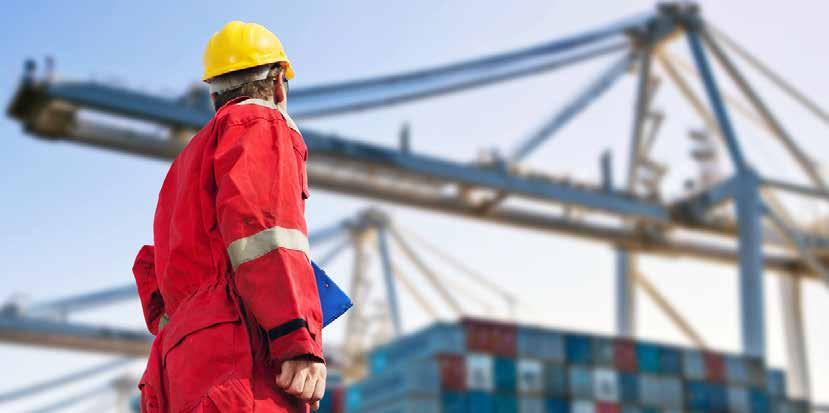
this way or another but it is a difficult choice for ports. It is easy to go to a conference and say ‘I don’t know the future’ but that translates in practice into the absence of direction and sporadic initiatives this way and that. Ports are doing things and they are more active than a year ago, but which way? The questions are still there.”
Aside from LNG, the different options are neck-and-neck, he says, and in the absence of clear direction, ports almost take their investment decisions based on ‘feeling’.
Despite these concerns, the Tracker found that investments in the field of alternative ship fuels faced the fewest obstacles to progress. More than 80% of ports reported that these projects were completed on time. So far, LNG (operational in 33% of ports) and biofuels (24%) show the best progress.
Guidelines, rules and regulations are needed for bunkering methanol, hydrogen and ammonia, says the report, which notes that a mix of fuels will be key to achieve net-zero emissions by 2050. “The pace of adoption of these fuels will strongly depend on the fuel availability and infrastructure in ports, and on policy initiatives.”
The good news is that ports continue in their drive for sustainability, although the Tracker results indicate fragmented progress depending on area of interest, region, size and cargo segment. “For many ports, sustainability is at the core of their mindset. The engaged ports are translating their discussions into local practices and taking initiatives on many fronts,” says Pallis.
The Tracker found that instead of the traditional ‘take-makedispose’ model, ports are investing in circularity, aiming to create closed-loop systems that are more sustainable, costeffective and resilient.
Cargo forecasts
Against the background of an uncertain world, the survey asked respondents at the beginning of the year about their expectations for cargo and passenger numbers in 2025. At the point of asking, more than 50% of container ports predicted a volume increase, with 25% expecting more than a 5% increase. In dry bulks, while 3% thought cargo would fall, almost half were looking positive. In tankers and gas carriers, 10% predicted a 2-5% decrease but 28% expected a 2-5% increase.
However, these figures were gathered in late February and March 2025, before the start of the US administration’s trade tariffs fandango and President Trump’s so-called ‘Liberation Day’ in April.
Where are we now? In a snap poll at the end of the IAPH World Ports Tracker webinar, the question was asked: “Now we have progressed to May, what do you see the expected outcome for cargo volumes overall in your port developing in 2025 compared to 2024?” The answers were still reasonably positive: 9% predicted a more than 10% increase, 12% went for a 5-10% increase and 21% for a 0-5% increase, while 18% expected volumes to be stable. That left 39% predicting a decrease in volumes.
ports must face up to a myriad of new and emerging threats, as well as explore opportunities to grow and diversify their business
Pictured: Today’s
Photo: Dreamstime

Does regular environmental monitoring take place in your port for the following parameters?
“The poll at the end of the webinar was not super-positive – they don’t expect a surge of cargo – but the mood was reasonably positive and had not changed,” says Pallis.
Inevitably, most of the ports which contributed information and data to the Tracker are the more active of IAPH’s members and/or the larger ports with resources to research and complete the survey. Nevertheless, the work absolutely captures trends and will continue to do so, adds Pallis.
Patrick Verhoeven expressed his thanks to all the IAPH member ports who participated in the live webinar: “You have provided a basis for an annual report that you will be able to simply update on an annual basis, based on the information you can provide and share with us online on our membership portal,” he said. He also encouraged those that did not take part to do so next year. ■

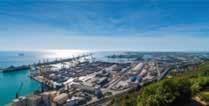


The World Ports Tracker is available to IAPH members only and can be accessed via the secure area of the IAPH website. For a summary of the report, visit the WPSP website: sustainableworldports.org or click this link: http://bit.ly/4nr9cMT
Port finance options grow
Recognition of the positive returns available in the port sector is underpinning growth in the creative provision of financing at all levels
MIKE MUNDY
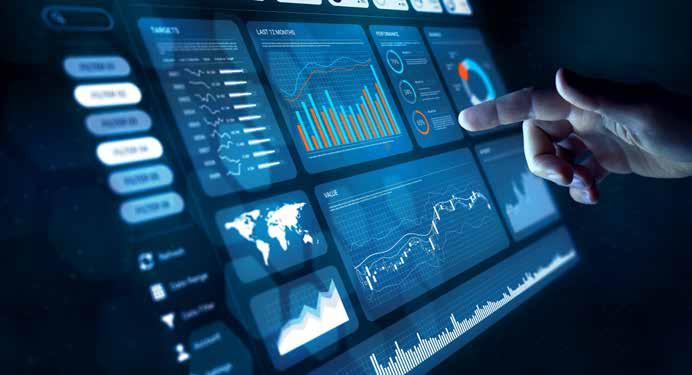
There is no lack of creativity in the port and terminal finance sector nowadays.
The industry has largely relinquished the title of an overlooked area of potential investment, spurred on by the advance of port privatisation projects. As a consequence, finance options have expanded accordingly for both large capital expenditure projects and more niche requirements.
David Wignall, managing director, David Wignall Associates, a well-known party in the arena of inward port investment, summarises the general position concisely. He sees four distinct categories with financing requirements and tailored solutions. Basic infrastructure, such as land or breakwaters projects tend, he says: “to lend themselves to long-term government or bond financing if the port authority has a strong balance sheet.”
Furthermore, “when developed by government, and the
operations are maturing, they can be refinanced to private sector infrastructure funds,” Wignall adds. “Plus, multilateral lending is also in evidence in this area.” This is lending by multiple financial bodies, usually aimed at sharing risk and typically involving institutions such as the World Bank or regional entities such as the European Investment Bank (EIB) or African Development Bank (ADB).
India investment
One contemporary major project in this area is the Vadhvan Port project (VPPL), a deep draught port to be established in
availability
more data today facilitates enhanced due diligence when it comes to financing port and terminal and terminal projects Photo:Shutterstock
Pictured: The
of
India’s Palghar District, with an eye to meeting long-term capacity requirements. This is a joint venture project between the Jawaharlal Nehru Port Authority (74%) and the Maharashtra Maritime Board (26%), two government agencies. The approach taken by these two agencies is to raise up to US$3bn in long-term debt – 15 to 20 years –via both onshore and offshore markets, in two phases. Additionally, the two partners will introduce Rs130bn (US$1.5bn) in equity.
The strong financial status of both entities facilitates such an approach, but where this is not in evidence then it is more likely that agencies such as the World Bank or ADB will be involved.
Intriguingly, Wignall describes the second major area of investment— terminals and associated infrastructure — as more of “a grey area.” He notes that finance provision in this segment can be similar to basic infrastructure financing or can be achieved by private sector financing. Equally, it can be a combination of both. Much depends, he notes, “on the strength of the revenue case and security of traffic and tariff.” Engineering Procurement and Construction (EPC) finance is another alternative, with this provided by the contractor concerned. This has been visible with Chinese contractors under the well-publicised, Belt and Road initiative (BRI).
This latter scheme has had its successes but also its failures, as well as increasingly running into political spats. It is accused by US interests, in particular, of being a means of China extending its political influence and power abroad and as such of not being a wholly commercial instrument. Sri Lanka’s Hambantota Port, for example, is a project that has been cited as a failure, or more specifically a ‘debt trap’ whereby the new port was unable to generate sufficient revenue to pay for itself and thus it was eventually leased to a Chinese company as an alternative to repayment.
Strings attached
Of course, cynics might also argue that debt diplomacy has long been at play elsewhere, among countries tied to the multilateral financing system of the so-called Bretton Woods institutions, like the World Bank and International Monetary Fund.
There are always conditions attached to any financing agreement and, as demonstrated above, sometimes big penalties to pay if things go wrong. Another such eventuality is if a loan repayment cannot be paid within a certain timeframe there is a ‘financial bubble’ to pay at the end of the term. This, in turn, highlights the importance of getting your project due diligence right. This includes considering the impact of loan conditions which, when leant by parties such as the World Bank or EIB, can have extensive requirements related to workers’ rights, conditions of employment, sustainability conditions and so on.
The third area Wignall identifies is what he terms ‘superstructure’ – broadly, the equipment employed on the quay and landside. Typically, this is achieved through balance sheet financing and a mix of other structures such as local
bank loans. Sometimes there is also the possibility of grants, for example through a national fund awarded to a certain country by EIB or under some other broad-based initiative. Again, rigorous conditions can apply and must be considered in-depth.
Wignall’s fourth area of financing is marine services, and here, he notes that export credits are becoming much more influential in the financing equation. “There are issues emerging in decarbonisation. Are electric harbour craft and sustainable tugs going to be successful? Debt and asset financing,” he adds, “are, as a result, becoming more difficult and requiring more equity to underpin asset purchase and operation. The influence of Chinese and export credit in this area is more and more apparent.”
Sustainable finance
ING Research notes that in 2024, after a dip in 2023, overall sustainable finance returned to a strong growth mode with this expected to continue over 2025. The concept of sustainable finance has matured at a relatively fast rate in recent times.
Taking sustainable port infrastructure as an example, as highlighted in a recent presentation by Prof. Giovanni Satta, University of Genoa, it is noted: “The International Capital Market Association (ICMA) plays a key role in the development of green finance, promoting sustainable practices in the bond and debt capital markets. ICMA is responsible for managing various principles and guidelines that govern the issuance of green, social and sustainable bonds. These principles effectively constitute the global standard for issuing sustainable bonds in the international market (cited by 97% of issuers in 2024 - ICMA).”
Further, it notes: “The Loan Market Association (LMA), the Asia Pacific Loan Market Association (APLMA) and the Loan Syndications & Trading Association are key organisations in the sustainable finance sector, particularly regarding green and sustainability-linked loans. These organisations have collaborated to develop clear principles and standardised practices that support responsible investments in green and sustainable projects.”
Aside from increasing market interest, driven by supply chain policies, the presence of structures such as those above is a strong catalyst to the delivery of sustainable finance which is proliferating in the ports sector. As an example, Dan Clague, chair, Isle of Man Steam Packet and well-known finance guru, pointed out the availability of specialist funding for decarbonising equipment capital expenditure, which, he says, is “quite interesting for operators wishing to upgrade to electric yard equipment.”
It doesn’t always have to be a big requirement – it can be niche too. ■
Investment and port financing will be one of the central and recurring themes of the IAPH 2025 World Ports Conference in Kobe, Japan on 7 to 9 October 2025. For more information visit: worldportsconference.com
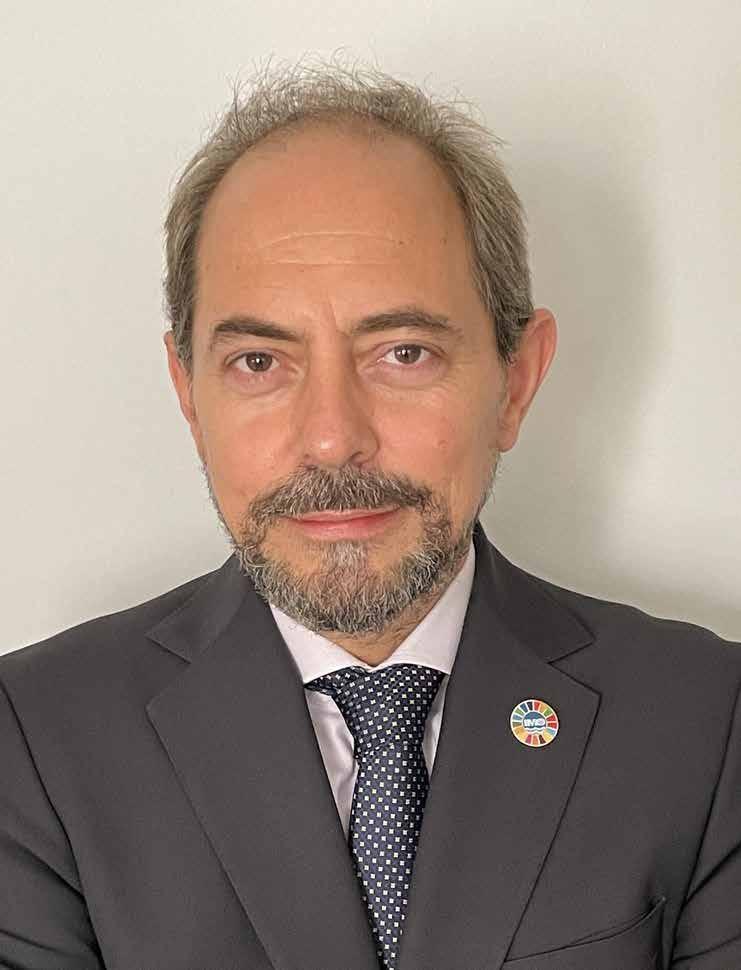
Antonis Michail
Launched in 2018, the World Ports Sustainability Program (WPSP) was conceived as a unifying initiative to integrate the UN’s Sustainable Development Goals (SDGs) into port governance and operations worldwide. It was designed to inspire change, and to measure, share and drive it across the global port community.
It has now developed a life of its own, with over 515 projects on the database, plus a hugely-successful awards scheme that runs parallel to it. This year, the IAPH Sustainability Awards received a record number of entries — 120 in total, up from 70 last year.
With a long background in ports, engineering and sustainability, IAPH technical director Antonis Michail is the perfect man to lead the initiative.
“We launched WPSP back in 2018, inspired by the UN’s 2030 Agenda and its 17 SDGs,” he says. “Our goal was to use that framework to rethink how ports approach sustainability. Ports have long focused on environmental issues like emissions and other externalities of port operations, but SDGs push us further — into areas like zero poverty and quality education. These were not traditionally on the radar for most ports, yet they are highly relevant. WPSP encourages the sector to broaden its scope and reclassify its actions through this global lens.”
At the heart of it all is the vast and growing WPSP database, a valuable resource for the port industry on all areas of sustainability. Open to non-IAPH members as well, it categorises flagship projects from across the globe according to SDGs and six core focus areas: infrastructure, digitalisation, climate and energy, environmental care, community building, health, safety and security.
“It started small, but we now have over 515 initiatives from all corners of the world, from mega-hubs to smaller, developing ports. What's powerful about the database is not just the knowledgesharing — it’s also a tool for sector-wide analysis. We can identify trends, gaps, and even underrepresented SDGs. It
The IAPH World Ports Sustainability Program has become a beacon of best practice for the industry, going from strength to strength since its 2018 launch. Antonis Michail, IAPH technical director, says it has grown into a truly global platform, but still wants more ports to get involved
MARTIN CLARK
becomes a source of inspiration. Ports see what others are doing and think: Why not us?”
This aspect is a key part of the job for Michail, who is constantly in awe of the amazing work taking place at ports, large and small, across the world. But it is also effecting real change as ports adopt and embrace new ideas and technologies from the database. One example is the work of ECOncrete, a nature-enhancing technology used in port structures to boost biodiversity. It started in San Diego, and now ports in Spain, Denmark, and elsewhere are adopting it.
“We also see great social initiatives — in Kenya, for example, the port authority owns and supports local sports teams to engage youth and combat poverty. That’s a creative community-building effort. When you see a project like that, it challenges your assumptions about what port sustainability can look like.”
Out of this came the IAPH Sustainability Awards, recognising excellence in the sector, and open only to IAPH members. A surge in submissions this year resulted in the jury growing from eight to fifteen members in order to evaluate the projects. The awards highlight a diverse range of ports, from the very largest to smaller ones in developing countries, and underscore that innovation is not limited by scale. The highlight of the IAPH World Ports Conference in Kobe in October will be a gala dinner to announce the winners — a glittering ceremony worthy of the ‘Oscars’ tag that one winner attributed to the event.
While the database represents the first pillar to the WPSP, and the awards a second, the third pillar is the
work that goes on around capacity building. That includes the Port Endeavor game, a unique training tool developed in partnership with UNCTAD TrainForTrade and the port training institute of the Port of Antwerp-Bruges, APEC.
“Port Endeavor is a serious game designed to teach sustainability through decision-making,” says Michail. “Participants play as teams managing a fictional port and must tackle real-world challenges, with limited budgets, all based on actual projects from our database. It’s a fun, practical way to understand how certain actions align with different SDGs.”
The game is available in three languages, with more on the way, and has been played in all continents of the world. At Kobe, there will be a Japaneselanguage version of the game available.
“We’re also currently exploring a potential fourth pillar: a sustainability accreditation scheme, most likely starting with the cruise sector. There’s also a mentorship programme being considered to connect ports on different parts of their sustainability journey. But the core idea remains — ports learning from each other and working together."
While all eyes will be on Kobe this October, and the unveiling of the 2025 award winners, Michail is keen to continue the growth and evolution of WPSP, with an open invite for all to take part.
“If you’re not yet part of WPSP — join us! Study the online database. We give visibility to your work, we celebrate innovation and we give your projects new life through training and recognition.” ■ View the database: https:// sustainableworldports.org/project-database and vote for the 2025 winners in August!
World Ports Sustainability Program
With the IAPH Sustainability Awards 2025 set to be unveiled at the World Ports Conference in Kobe this October, P&H looks at how the WPSP initiative has captured the imagination of port professionals around the globe
The World Ports Sustainability Program (WPSP) aims to demonstrate global leadership of ports in contributing to the Sustainable Development Goals of the United Nations. The initiative aims to empower port community actors worldwide to engage with business, governmental and societal stakeholders in creating sustainable added value for the local communities and wider regions in which their ports are embedded.
It is an initiative that has drawn attention from ports and their communities around the world. There are now more than 516 projects and over 191 ports in 71 countries worldwide showcasing everything from clean energy excellence to community building. Here, P&H captures in data form a snapshot of the success of the programme. ■
Visit: sustainableworldports.org
WPSP database of sustainability projects

Top ten countries (number of projects)
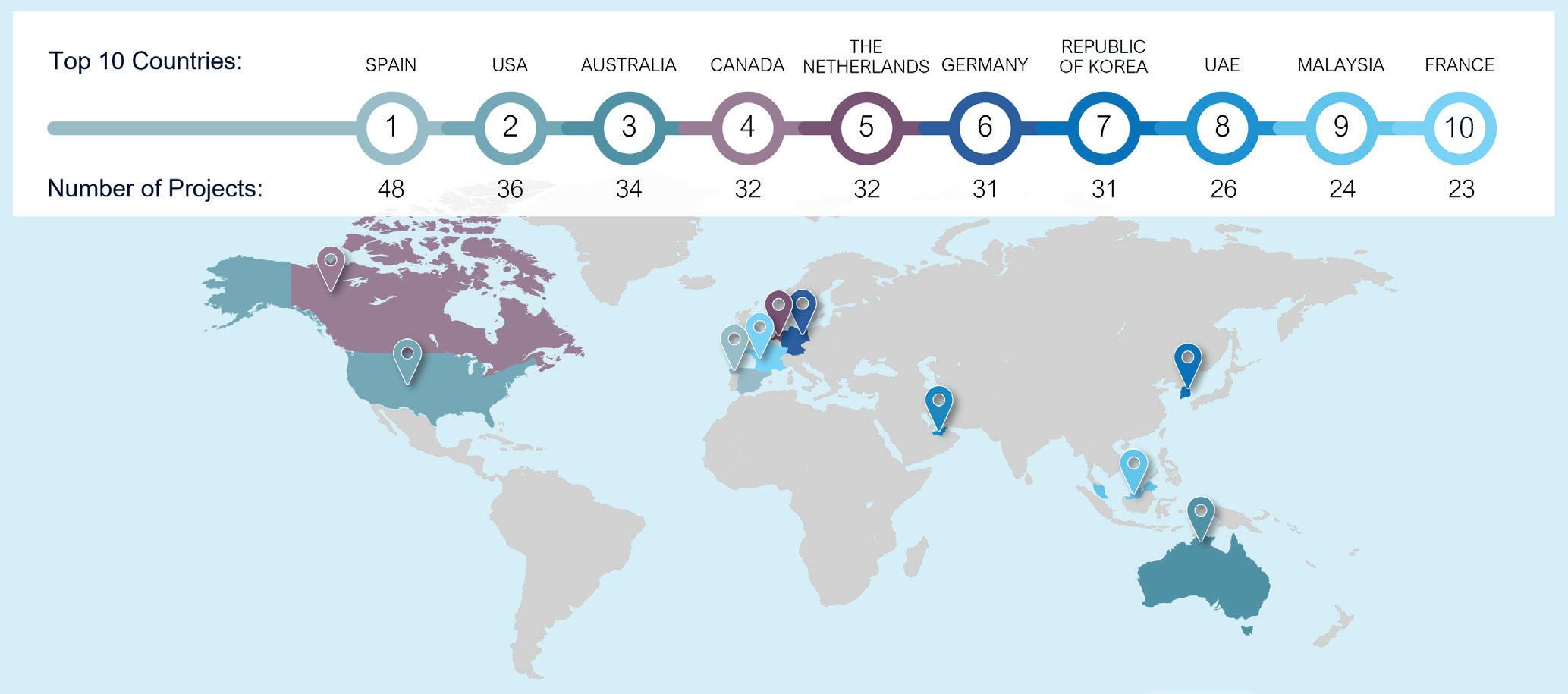
Number of projects per SDG
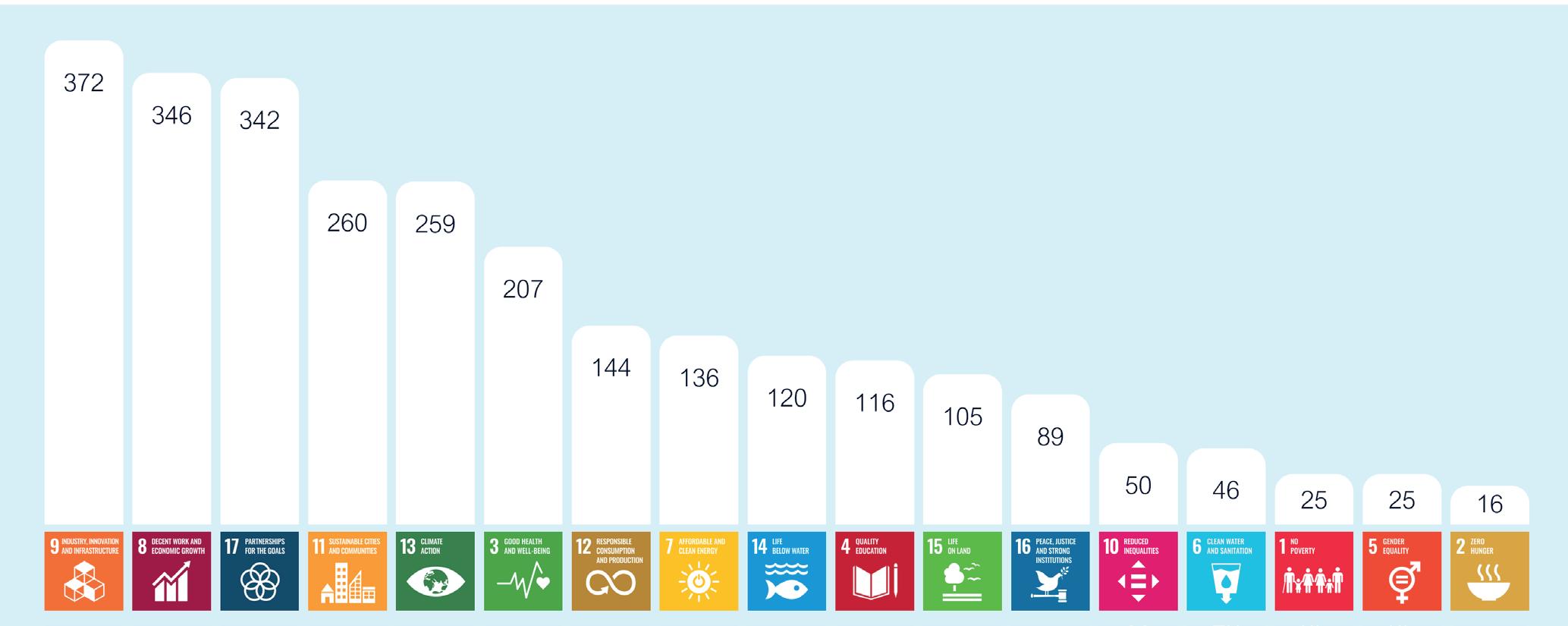
Number of projects per area of interest
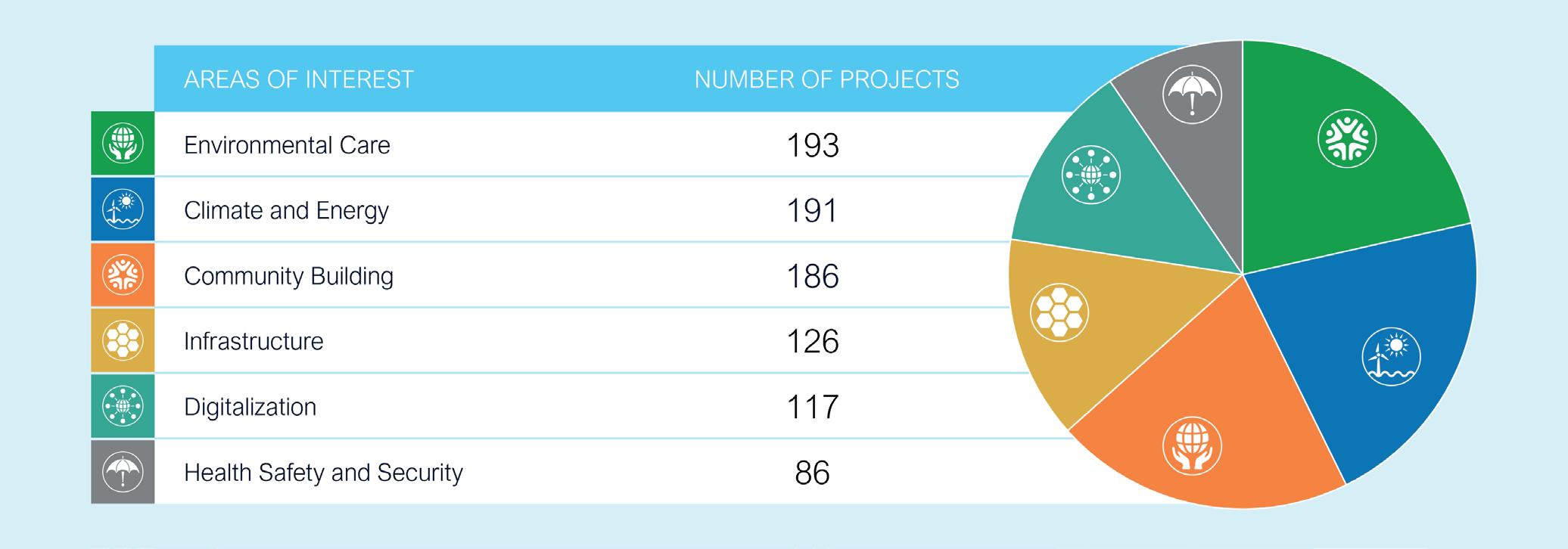
Top ten ports (number of projects)
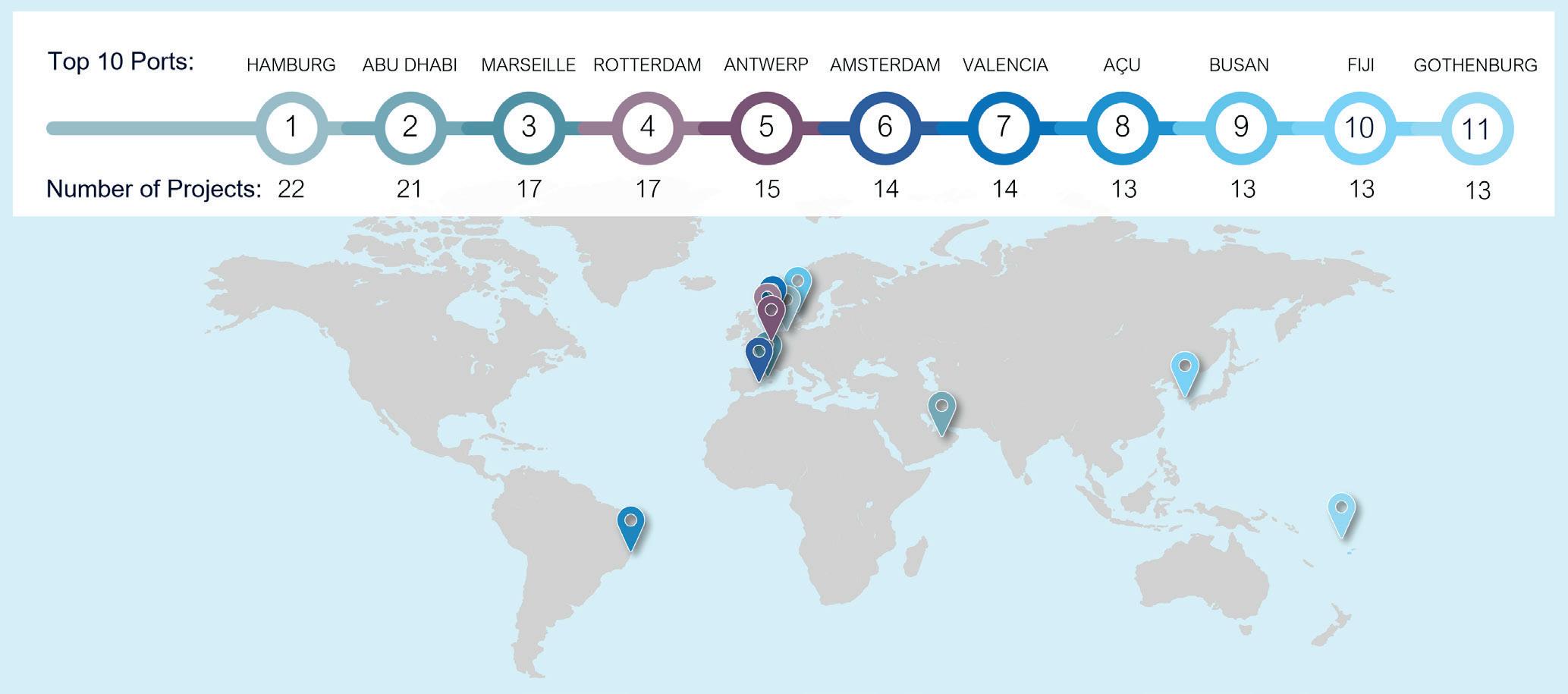
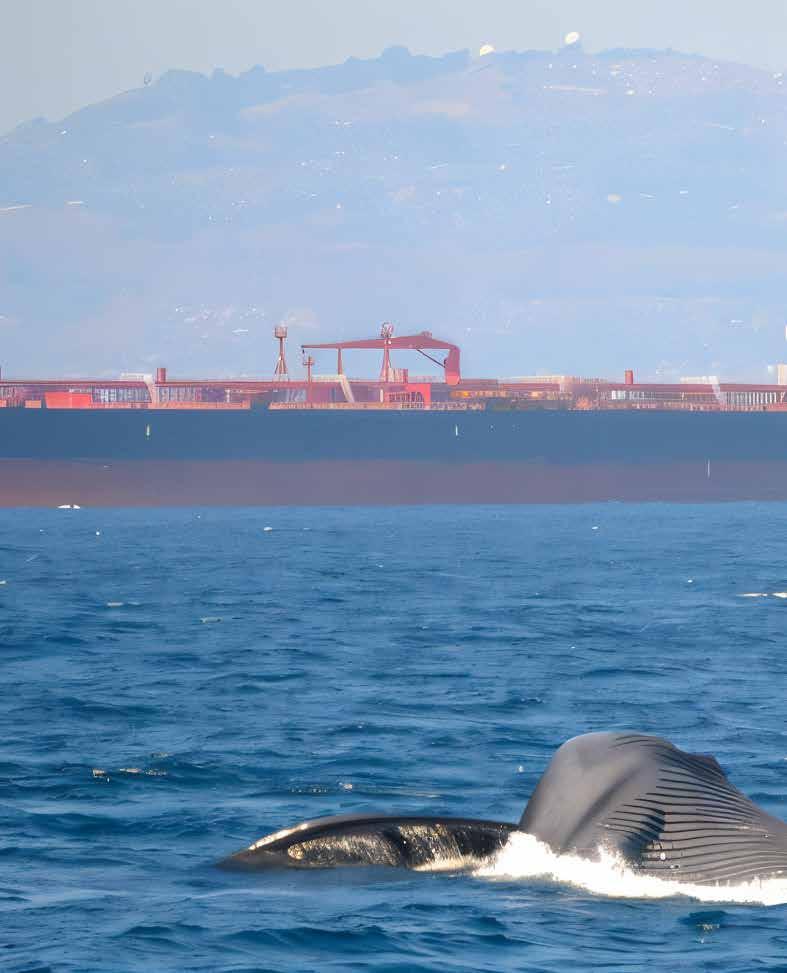
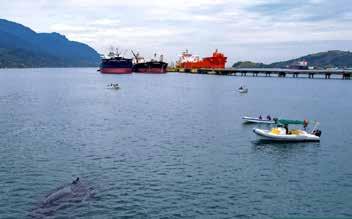
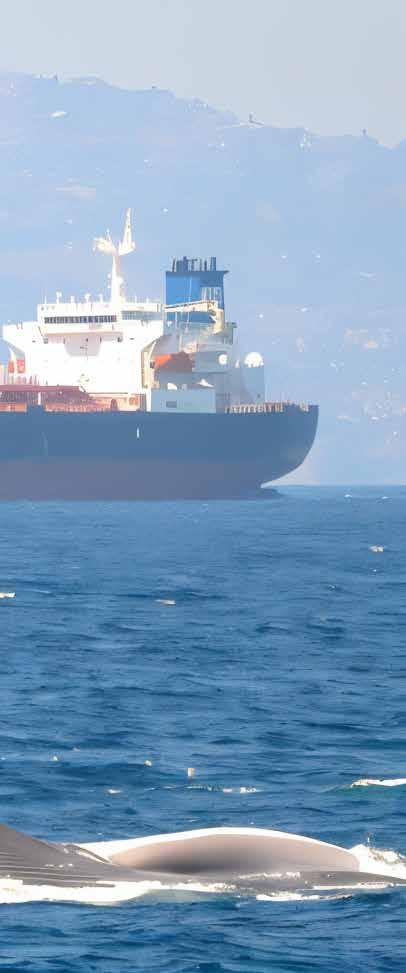
LOOKOUT WHALE GUARDIANS
Ports saving whales
Ports around the world are continuously innovating and, in recent years, most have begun to deepen their focus on issues like sustainability and conservation. That includes whale protection, an area championed by non-governmental organisation (NGO), Whale Guardians. It works alongside ports to protect whales, something that brings with it surprising environmental benefits too.
Blue whales are earth's largest animal, but today their population stagnates at 3.5% of its former 300,000. Other species face a similar decline. Few people realise, however, that these oceanic giants are vital to our planet’s health. Whales fertilise the ocean with nutrients, fostering the growth of phytoplankton. Similar to plants, phytoplankton absorb carbon dioxide from the atmosphere. They are responsible for no less than 40% of global carbon capture and storage. Restoring whale populations therefore contributes to the fight against climate disruption.
Ports can play their part in making a difference. Each year, thousands of whales die due to unintentional ship strikes. Fortunately, many of these fatalities could be averted through leading ships into the port over a route avoiding areas with high whale activity, without compromising safety. Whale Guardians collaborates with ports, harbours, shipping companies and local scientists to implement these voluntary strategies, reducing collision risk.
About 85% of ports have resident or seasonal whales in their waters. Petrobras's Tebar Terminal at the Brazilian port of São Sebastião, home to thousands of humpback whales, decided to partner with Whale Guardians and researchers from Instituto Baleia Jubarte. Together, they implemented data-driven collision prevention measures. Tebar operators are relieved that whales in their port region are safer, declaring 100% cooperation from ships, and have proudly added the conservation partnership as a milestone in their history. Crucially, strong emphasis is placed on ensuring shipping activities continue to run smoothly.
This collaboration showcases how industry and conservation efforts can align for the greater good. But more work needs to be done. Ports and shipping companies can play a pivotal role today in the protection of tomorrow’s marine life. As port captains have a high impact on directing shipping traffic in their region, their support for this initiative makes all the difference in reducing collision risks. Together, it is possible to ensure that these magnificent creatures continue to thrive in our oceans. ■ For more information visit: whaleguardians.org
Main Picture: A blue whale surfaces close to a tanker in front of the Palos Verdes Peninsula, within a few miles of the entrance to the Port of Los Angeles
Inset: A whale near the Brazilian port of São Sebastião
All photos: whaleguardians.org
REGIONAL FOCUS NORTH AMERICA
Transpacific tensions
Feathers are being ruffled in Transpacific container routes between East Asia and North America as a result of trade tariffs and sensitive geopolitical tensions. But are things as bad as feared….yet?
AJ KEYES
lobal container traffic was estimated to be around 180 million TEU in 2024, which converts to an estimated 925-950 million TEU handled across the port industry. To put the Transpacific trades into context, the total eastbound and westbound activity has a share of around 25%.
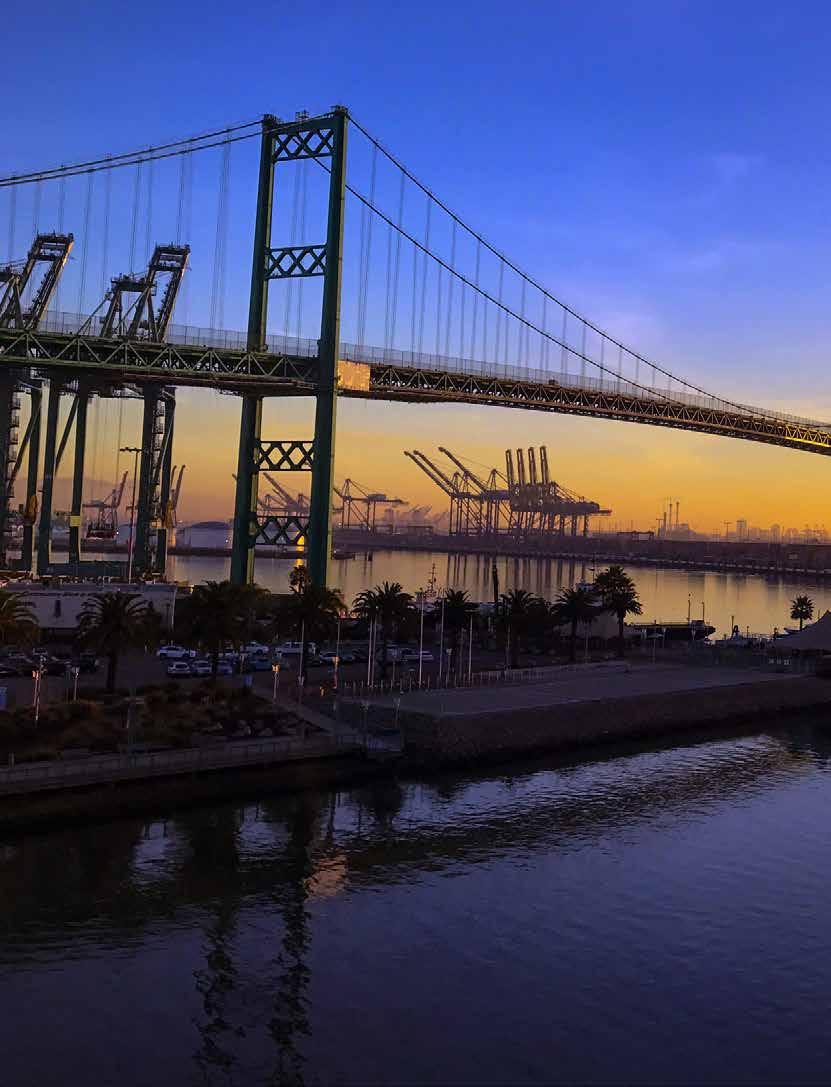
GVolumes at ports on the West Coast of North America include 20 million TEU in San Pedro (CA), with Oakland (CA), Seattle-Tacoma (WA) and Vancouver (BC) collectively adding a further 10 million TEU annually. Almost all of this activity is linked to trade with Asia across the Pacific.
Clearly, these are substantial container volumes being shipped between two significant trading blocs, so any disruption to the status quo has the potential to impact ports, shipping lines, logistics service providers and, therefore, consumers.
Pictured: Tariffs and geopolitical tensions have tested Transpacific routes in 2025
Photo: Dreamstime
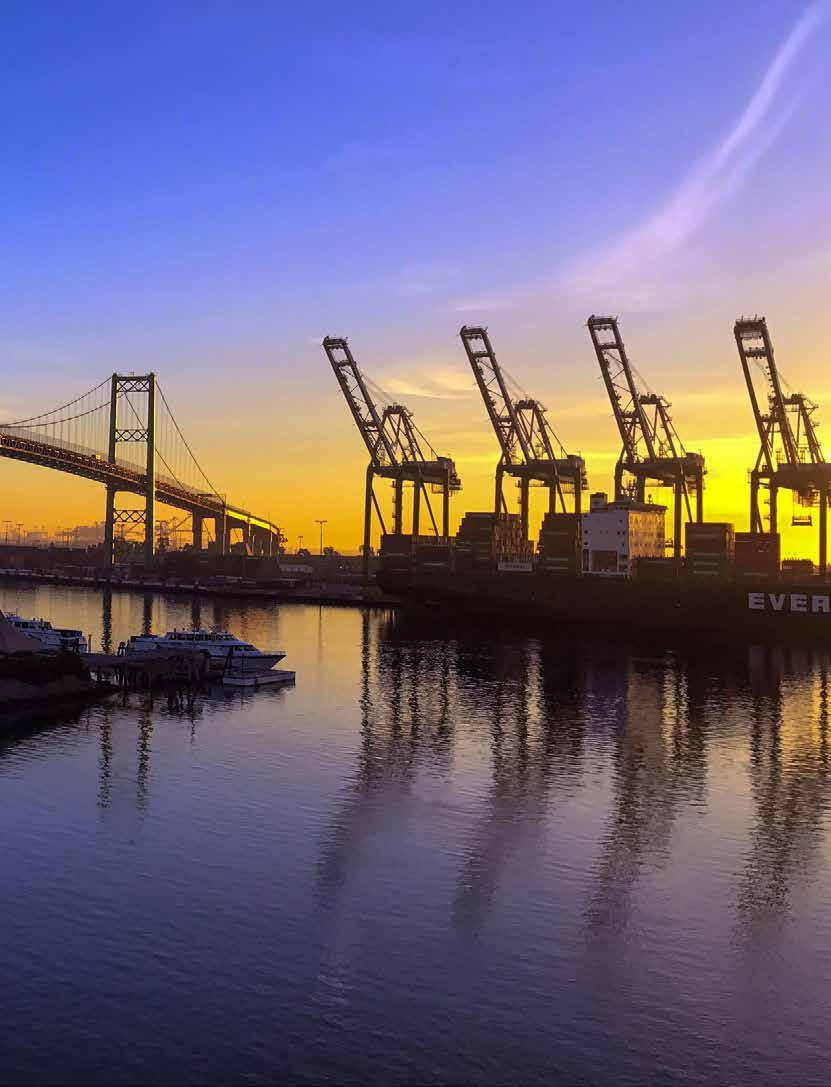
Source: Port data
Source: Port data
Trade tariffs and geopolitical tensions are hot news in the Transpacific container trades in 2025. Los Angeles Mayor, Karen Bass, held a roundtable in early June 2025 and there were grave concerns from participants, including Gene Seroka, port director at the Port of Los Angeles, who commented: “During the past seven days, we've averaged about five ships in port. Normally that should be about 10 to 12. Job orders for our dock workers at the International Longshore and Warehouse Union are down nearly 50% compared to what they should be. We can see things a lot earlier in this supply chain based on orders and manufacturing overseas before it hits home here on the ground in the United States. As goes the Port of Los Angeles, so goes the American economy with less cargo coming through here. That means fewer selections on store shelves and online buying platforms, likely higher prices. We're at a critical point where typically at this time of year, orders are going into factories in Asia for the all-important year-end holiday season.”
These comments were endorsed in the port’s media briefing in mid-June 2025, which confirmed a total of 716,619 TEU in total was handled in May 2025, representing a 5% drop on May 2024 and, importantly, bringing to an end 10 straight months of year-on-year growth – and this is being attributed to the impact of tariffs.
“May marked our lowest monthly cargo output in over two years,” stated Seroka, adding: “While May volume is typically stronger than April as we approach our traditional peak season, our imports dropped 19% compared to last month.”
Industry perspectives
Clear concern from Seroka moving forward, but it’s a view shared by Lee Kyung-Gyu, president of the Incheon Port Authority, who provides insight from South Korea. “Last year, we encountered negative factors such as a surge in ocean freight charges from the Middle East and an intensifying trade dispute between the US and China…this year, the internal and external environment remains tough, with concerns about exchange rates, sluggish domestic demand, and the Trump administration's second term tariff policy.” Although not solely Transpacific issues, enough concern, nonetheless.
A similar trend is also appearing at the North West Seaport
Alliance, comprising the ports of Seattle and Tacoma, when it highlighted ongoing issues. A spokesperson for the ports commented: “For the last week in May, volumes were down for the fourth consecutive week. Almost all the vessels that did call were also carrying less volume than expected from recent trends. Vessels that arrived the week of May 26th to May 30th would have departed Asia after several weeks of the higher tariffs rates being in effect and before the pause was announced. This further reduction in volumes likely demonstrates the continued impacts of the elevated tariff rate.”
Mario Cordero, CEO, Port of Long Beach, agreed that “uncertainty remains for the business sector,” although he is slightly more upbeat than his fellow executive in the San Pedro complex: “We remain cautiously optimistic that import cargo will rebound at the end of June and into July just in time for the peak shipping season, when retailers stock the shelves with back-to-school supplies and begin preparations for the winter holidays,” stated Cordero.
Ernie Tedeschi, director of economics at The Budget Lab at Yale, a non-partisan policy research centre which analyses the impact of federal policy proposals on the American economy, discussed the impacts tariffs have had on American consumers on the same mid-June briefing as Seroka.
He had a stark warning about the current tariff situation, saying prices are rising. He cited an example of apparel arriving from Asia being 28% more expensive at the moment and summarised the overall situation: “A half point impact is a floor, not a ceiling…but the damage (over the tariff situation) could be great…..” In summary, Tedeschi estimates that tariffs could raise average prices by 1.5% in the US, a loss in purchasing power of nearly US$2,500 per household per year, impacting poorer households the most.
Concerns being raised across the industry seem wellfounded, if looking at current year-to-date container trends that are developing. Figure 1 endorses the drop in volumes for April and May 2025 for loaded imports for both ports in the San Pedro complex.
Not just tariffs raising concerns
Yet it is not just the impact of tariffs potentially impacting container Transpacific activities, with the prospect of fees being levied on Chinese-built ships, a Ships Act to support US domestic vessel production and investigating supply-chain choke points and whether they pose a threat to US interests — all currently hot topics.
The planned additional fees on Chinese vessels has a stated intention of deterring reliance on Chinese maritime assets, without disrupting US exporters or smaller regional carriers — an interesting prospect and one that will impact one of the Transpacific’s major shipping lines, COSCO.
The Office of the US Trade Representative (USTR) confirmed from mid-October 2025, fees on owners of Chinese-built container ships will be levied under the higher of two formulas: either US$120 per container discharged, rising to US$250 per container over the next three years, or US$18 per net ton of the ship, rising to US$33 per net ton over the same period.
Figure 1: Loaded Imports, Ports of Los Angeles & Long Beach, January-May 2025 in TEU
Figure 1: Loaded Imports, Ports of Los Angeles & Long Beach, January-May 2025 in TEU
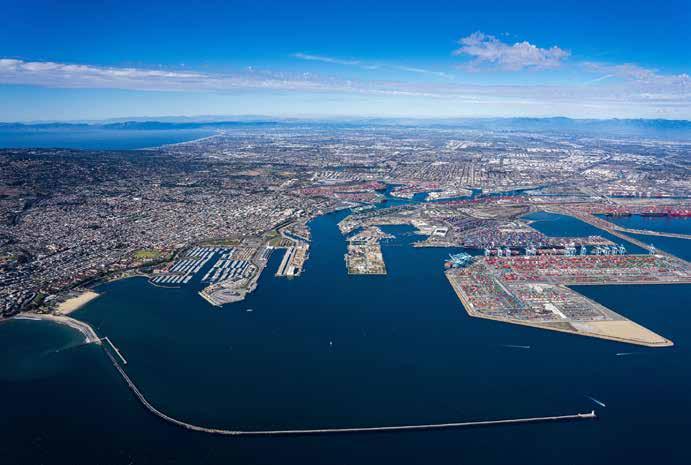
Concerns being raised across the industry seem well-founded, if looking at current year-to-date container trends that are developing ‘‘
So, what does this really mean? On this basis of paying US$120 per container, an 8,000 TEU ship can expect to pay around US$1 million extra. The policy will place Chinese operators like COSCO at a cost-disadvantage compared to non-Chinese competing ocean carriers, even allowing for the fact that the fees being imposed have been reduced considerably compared to the Trump Administration’s original plans.
For COSCO, there are clearly two options to continue trading in the Transpacific – namely, deploy ships smaller than 4,000 TEU in size (and lose the economies of scale that are gained from the use of Ultra Large Container Vessels) or increase slot allocations across the Transpacific on Ocean network services operated by CMA CGM and Evergreen strings – again, not ideal because COSCO then loses operating flexibility from its own ships and must hope service partners have sufficient capacity available.
Clearly, neither option is one that will appeal to the Chinese-
controlled shipping line, but the concern is whether these additional costs will be passed on to US consumers.
Higher prices, fewer selections
The Economist Intelligence Unit (EIU) said that it “anticipates a 20% reduction in China’s exports to the US over 2025-27….with the majority of the impact being felt in 2026, with some resilience in 2025 owing to trade front-loading, the initial inelasticity of trade and the gradual nature of tariff imposition.” So, while it is too soon to see the impact of volumes on China’s container ports, the same is not true for USWC facilities.
“Unless long-term, comprehensive trade agreements are reached soon, we’ll likely see higher prices and less selection during the year-end holiday season,” concluded Seroka at the recent media briefing on the subject of tariffs. “The uncertainty created by fast-changing tariff policies has caused hardships for consumers, businesses and labour.”
For US consumers, he issued a warning: “Expect higher prices and fewer selections in the Halloween and holiday seasons” in 2025. ■
Pictured: May 2025 volumes, including loaded imports from Asia, dropped for both ports in San Pedro and concerns are growing that US consumers relying on Transpacific cargo are going to see fewer choices but higher prices for this year’s holiday season
Photo: Courtesy of the Port of Los Angeles
Cybersecurity by design
With technology moving so fast, and new threats emerging all the time, building cyber resilience into port operations needs to begin right from the very start
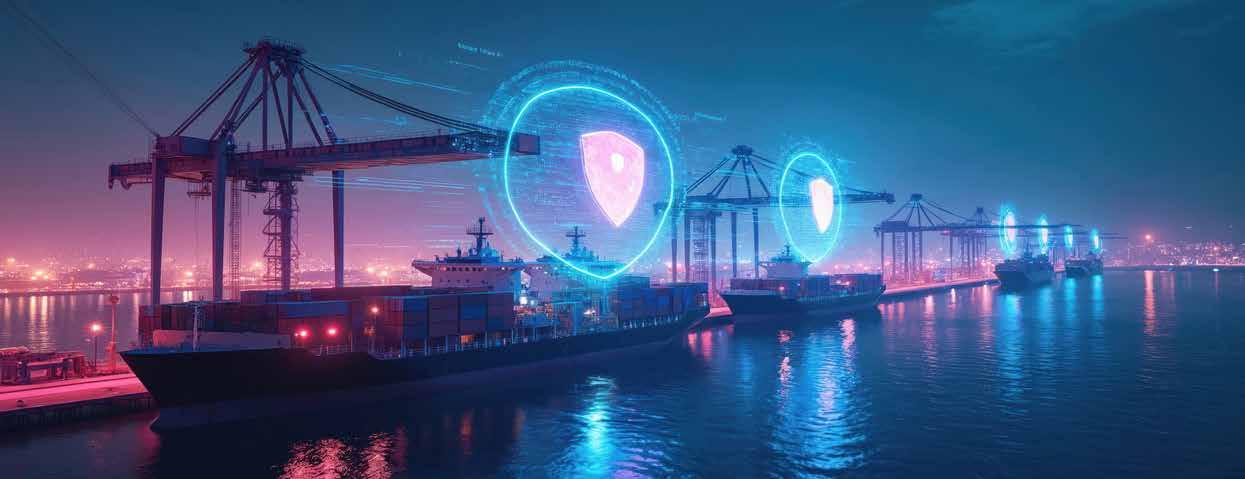
Technological progress has shaped our world for millennia, from the Stone Age to the Information Age. However, the pace of change in recent decades, with the advent of computing, global connectivity and mobile devices, has brought with it unprecedented transformation across our society, ripping up old business models and reshaping how we interact with one another.
These technologies have together unleashed a torrent of advances in the digital space, including the emergence of artificial intelligence (AI) and super-powered quantum computing, both of which perhaps herald the beginning of another new era.
For some, it presents an existential threat to our world, while for others, it is viewed as a tremendous opportunity to improve it. While the truth may, in fact, be somewhere in between, what is certain is that this rapid pace of change is here to stay.
For ports, finding a safe path through this fast-changing digital landscape presents a challenge. The emergence of
cyber attacks and the use of unauthorised drones has already tested port authorities around the globe. It seems logical to conclude that these challenges will continue and that other threats will evolve.
To this end, IAPH has published new guidelines to help ports and the wider maritime industry face up to these and other challenges with greater confidence and awareness.
Cyber Resilience: Guidelines for Emerging Technology in the Maritime Supply Chain is the result of months of hard work by a dedicated team of industry professionals and addresses seven cyber technologies, including drones, AI and quantum.
Other areas covered in the report include 5G, automation, green energy and Internet of Things (IoT).
MARTIN CLARK
Pictured: Cybersecurity is a challenge facing the entire maritime ecosystem as interconnectivity increases between ports, shipping and other industry players
Photo: Dreamstime
Early awareness
Gadi Benmoshe, managing director of Marinnovators Consulting and vice-chair of the IAPH’s Data Collaboration Committee, was the project lead who brought it all together.
“The implementation of emerging technologies in the maritime supply chain is getting wider, so it’s really important to raise awareness of this issue among our community,” he tells P&H.
He believes that despite the sometimes dizzying rate of progress, and the near constant emergence of new technologies, it is essential to act from a place of understanding, embedding cybersecurity measures at the port right from the very start.
“It is essential to implement cybersecurity by design, right from the early stages — to prepare now, not after the incident.”
While ports around the world are all unique, and at different stages of their development, it is important to look at cybersecurity risks and vulnerabilities introduced by these emerging technologies even if there are no plans to integrate them, he adds.
What’s more, while all of these technologies are transformative in their own right, each can impact one another, manifesting in the cybersecurity threats and challenges they may create.
Emerging threats
All of these emerging technologies are already impacting ports across the world, again, perhaps in different ways.
Automation is apparent in many processes already, while green energy is critical in the decarbonisation of port operations, with technologies like onshore power supply (OPS), hydrogen and smart grids being steadily deployed.
“Avoid the misconception that non-IT systems, such as green energy, do not require cybersecurity assessments and be prepared for new cyber risks that these technologies might introduce,” warns Benmoshe.
“These systems often rely on legacy Industrial Control Systems (ICS) that weren’t designed with cybersecurity in mind. A cyberattack on a smart grid or OPS system could disrupt power to berthed vessels or even compromise port-wide operations.
“That’s why we are advocating for cybersecurity by design, segmentation, and hardening of ICS environments.”
Again, 5G is a game-changer because it enables ultrareliable, low-latency communication and massive connectivity.
This is essential for smart port operations — think autonomous vehicles, real-time cargo tracking, and remote crane operations.
“But with that connectivity comes a vastly expanded attack surface,” says Benmoshe. “Features like network slicing and virtualisation, while powerful, can be exploited if not properly secured. That’s why we emphasise strong encryption, secure identifiers like SUCI and SUPI, and robust intrusion detection systems in the guidelines.”
In short, he adds, these technologies are essential for the
future of ports — but only if we secure them properly from the start.
Prepare now
Digitalisation and the move to more sustainable energy sources has been a feature of the ports community and the broader maritime sector for many years, so it is not an entirely new threat that we face.
In his introduction to the new guidelines, Jens Meier, IAPH president and CEO of Hamburg Port Authority, compares this process as like a ‘stress test' for global supply chains.
On the one hand, he notes, it can improve the flow of information among stakeholders, yet on the other, increased digital integration makes the entire digital infrastructure vulnerable.
As a result, the sector is experiencing growing risks from cyber threats that can disrupt operations, compromise sensitive data and ultimately threaten security.
But much like NASA’s famous "Houston, we have a problem” moment, used to describe an unforeseen problem, Meier says many of the problems we face today are predictable, and the message that we must radiate is: "Houston, we have solutions".
As well as explaining and identifying the potential benefits of these technologies for ports and the wider maritime community, the new guidelines also include practical measures to detect, mitigate and protect against such cyber threats.
This includes training as well as appropriate supporting legislation.
The most important message, according to Benmoshe, is to prepare now, irrespective of how your port or organisation intends to utilise any of these technologies.
“It is not all bad news as these technologies present us with an incredible opportunity, in terms of innovation, growth and efficiency,” he adds.


“But we must be on the front foot right from the start. This means recognising that cybersecurity and resilience is not just another IT task, but a management responsibility, and one to be embedded throughout the entire organisation and industry chain.” ■ To download a copy of the new Cyber Resilience: Guidelines for

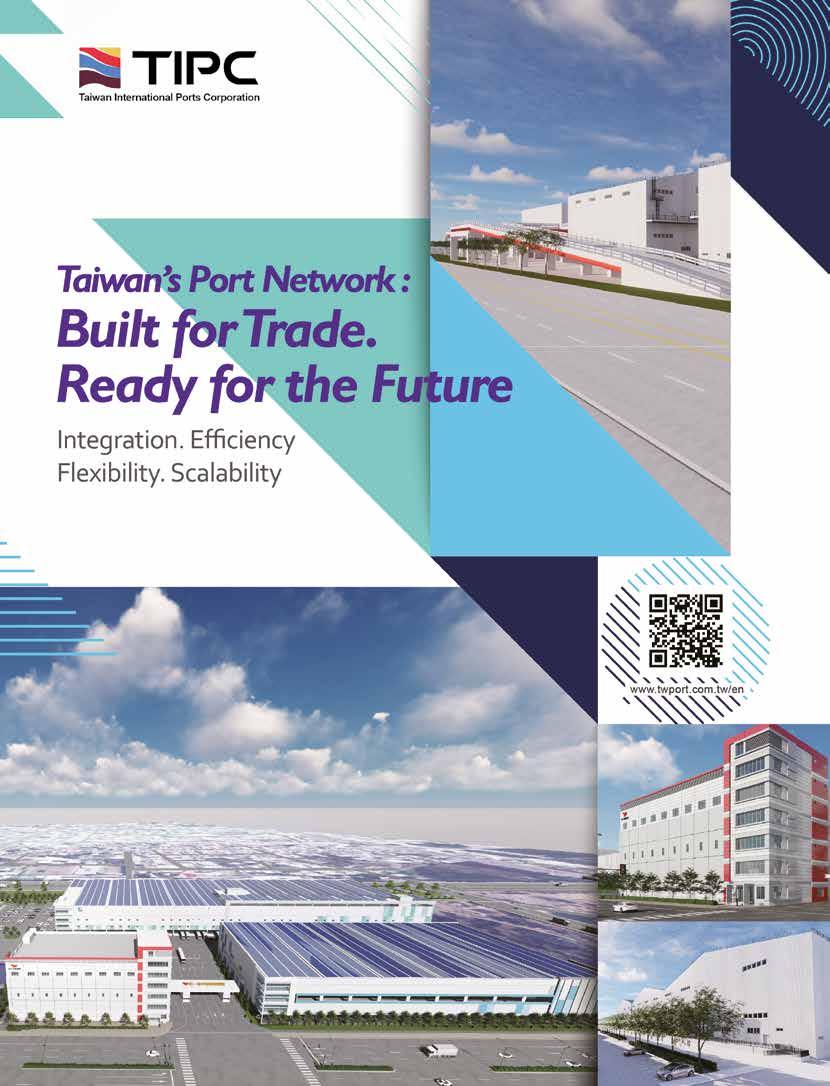

KEVIN GODIER Editor, International
Trade Finance
Wake-up call
How sustainability financing is bridging the gap between traditional investment objectives and urgent climate demands
The advent of climate finance mechanisms has reshaped funding and investment options for ports. There was a time when investment was linked primarily to returns or profit, still the crux of most transactions across other industry sectors. But the emergence of sustainability-linked financing has reimagined how things can be done in a more holistic way, with an emphasis on supporting climate objectives.
Development finance intuitions have been instrumental in rolling out such innovative programmes, but are now joined by commercial banks and specialist lenders. According to the World Bank, sustainabilitylinked financing instruments do not require the proceeds to be used for certain desired investment objectives, but instead can be tied to the achievement of predetermined environmental goals. This can tie the cost of borrowing to climate targets, providing an incentive for transformative sustainability policies.
Ports may have found a sweet spot in this convergence. In this context, sustainability measures might include a broad mix of digitalising operations, improving efficiency and the greening of both ports and shipping. That includes supporting ports in the energy transition. Export credit agencies, such as Belgium’s Credendo, are aiding in this process, with a ‘Green Package’, a series of incentives to support projects and firms that contribute to eco objectives. It is supporting engineering group John Cockerill in work to produce and export ammonia from India’s Kakinada port, for instance.
Ports are also on the front line when it comes to
climate adaptation and the looming threat of sea level rises. The World Bank’s concessional finance arm, the International Development Agency, allocated US$850mn to help Bangladesh develop its Bay Terminal port, not only to support growth objectives, but also to meet climate challenges. The infrastructure component includes a 6km climate-resilient breakwater and access channels. Large parts of Bangladesh remain highly vulnerable to flooding.
Investment bank JP Morgan suggests this funding will be essential if ports are to adapt to a new era of climate resilience. In a recent insight paper, ‘Sea Change: Port Infrastructure, Climate Risks and the Future of Global Trade’, it highlights how ports face risks from extreme weather and climate-related disruption with potential damage threatening infrastructure and commerce.
Estimates suggest a global requirement of US$223bn to US$768bn by 2050 for sea-level rise adaptation alone, it notes. It could be more. Given price estimates of US$57bn for coastal resilience upgrades on the Coastal Texas Project — a US initiative to deliver critically needed risk reduction from coastal storm surge — this number climbs higher when also accounting for extreme storms. With ports around the world facing up to this almost existential threat, the availability of sustainability-linked financing will be integral in adapting to the climate challenge, at the same time as expanding capacity to support global trade. With access to more flexible financial tools, ports can secure their place in this rapidly-changing world. ■

ABOUT THE AUTHOR
FUMIKO YAMAJI works on the IAPH communications team, based at the IAPH office in Tokyo, Japan. She is responsible for publications, including the documenting of the association’s 70-year history, soon to be commemorated in a publication available at the IAPH World Ports Conference.
Nine to five
The IAPH office in Tokyo, Japan is the administrative base of a truly global organisation, one that spans every continent. With the IAPH World Ports Conference taking place in Kobe this year, it is an especially busy period for the Tokyo team. Here, Fumiko Yamaji outlines a typical day at the office.
12 : 3 0 10 : 0 0 9 : 00 8 : 3 0

My commute to work takes about 30 minutes — 20 minutes on the train and a 10-minute walk from the station. Along the way, I often see the Meguro River flowing quietly, and just outside the station, the lush greenery of Kyu Shiba Rikyu Garden offers a refreshing contrast to the busy city streets. Our office is located in the heart of Tokyo, so I appreciate these peaceful moments before stepping into the day's work.
The office officially opens at 9:30am, so I try to arrive early to review emails and catch up on any other messages before the phone starts ringing. I settle in to work with a cup of hot water before I check in with our global membership and begin responding to inquiries.
As the host sponsor of the 2025 IAPH World Ports Conference, the City of Kobe joins our Tokyo team for a video meeting. We discuss key topics such as port tours and exhibition booth setup. We also coordinate with Mercator Media in the UK, which manages the conference, and work closely with our Europe team to ensure smooth communication.

Lunch is usually a quick affair at my desk, but occasionally the three of us — the girls on the team — go out together to a nearby Mexican or Japanese restaurant. Today, I had a tuna sashimi rice bowl at a place near Hamarikyu Gardens, another beautiful waterfront park. Despite the intense summer heat in Tokyo, the view there is refreshing and offers a brief escape.
8 : 30 6 : 00 5 : 3 0 4 : 00 3 : 00 2 : 00

I work on collecting materials for our 70th anniversary publication, reviewing historical records and photos from our archive.
I also explore to uncover behindthe-scenes stories about the founding of IAPH, especially those related to Gaku Matsumoto, our founder and first secretary general. I recently discovered that he had originally envisioned a World Ports Conference as early as 1922, the year the Ports and Harbours Association of Japan was established.

I receive an inquiry about the WPSP Sustainability Awards from a port authority in Japan, and I relay the questions to my colleague in charge at IAPH, who is based in Greece. When the matter is complex, we arrange a video call to ensure there are no misunderstandings and confirm the details clearly.

We hold a monthly internal meeting between the IAPH Europe team and the Tokyo team. During these meetings, we share updates on urgent preparations for the Kobe conference and follow up on various ongoing matters. Our team is truly global, with members based in the UK, Belgium, Greece and Japan. These meetings are essential to keep our internationally distributed team aligned and informed.

The building where our office is located sits next to Takeshiba Pier, so from the windows, we can hear the sound of ship horns and enjoy the beautiful view of the waterfront and the setting sun. I usually head home around sunset, surrounded by this serene scenery.

Dinner at home is usually prepared by either me or my husband, whoever gets home first. We enjoy a relaxed meal together, sharing stories about the day. Sometimes we watch YouTube while eating, often tennis matches. I’m a weekend tennis player myself, so I really enjoy watching other games. My husband enjoys mountain climbing, so we also sometimes watch hiking or mountaineering videos together.
I stay active by going to the gym or heading out for a run. I make it a point to exercise regularly to keep my energy up and maintain good health. I usually run twice a week to stay in shape and refresh my mind after a long day at my desk. One of my goals is to complete a 5-km run in under 30 minutes, I’m still training toward that!
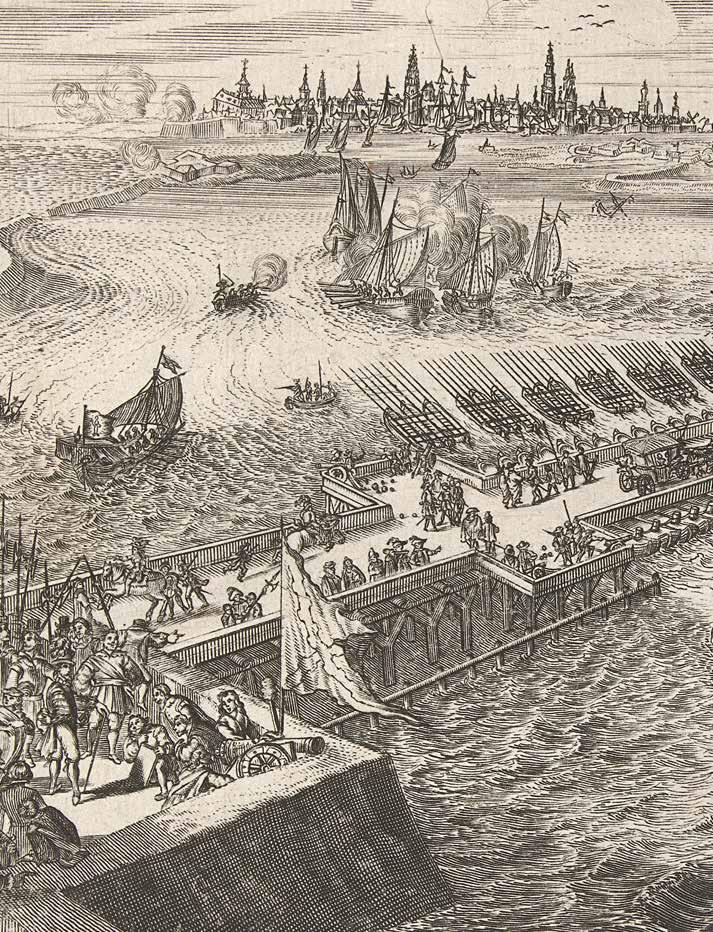
Ports in times of turmoil
The lessons of Antwerp’s storied past
PATRICK VERHOEVEN
In an era marked by renewed geopolitical instability, ports once again find themselves at the frontlines of global disruption. Trade wars, armed conflicts, and strategic posturing among great powers are reshaping the world’s commercial arteries. Nowhere is this more visible than in the maritime and port sectors, where supply chains are strained, shipping routes rerouted, and infrastructure increasingly subject to the pressures of global conflict.
Though this may feel like an unprecedented moment for many in the shipping and port industries, history tells a different story. The long view reveals that ports have always been vulnerable to – and shaped by – the turbulence of geopolitics. The case of the Port of Antwerp offers a striking example of how economic powerhouses can rise, fall, and rise again depending on the tides of war, diplomacy, and strategic interests.
Antwerp: A port shaped by power struggles
Antwerp’s strategic location along the River Scheldt has made it a crucial maritime hub for centuries. In the 16th century, the city was one of Europe’s most vibrant trade centres. At the time, Antwerp was part of the Habsburg Netherlands under Spanish rule, yet it maintained a reputation for religious tolerance and economic liberalism, attracting merchants, bankers, and skilled workers from across the continent – including many Protestants. This inclusivity, however, clashed with the increasingly repressive religious policies of Catholic Spain. As the Protestant Reformation swept through Northern Europe, tensions escalated. In 1584, during the Eighty Years’ War – a conflict that pitted the rebellious Dutch provinces against their Spanish overlords—the Spanish army imposed a maritime blockade around Antwerp. The goal was to choke the city into submission, and it succeeded. By August 1585, Antwerp surrendered.
Pictured: Romeyn de Hooghe (1670) - Le Pont Farnèse 1585
Photo: Amsterdam, Rijksmuseum
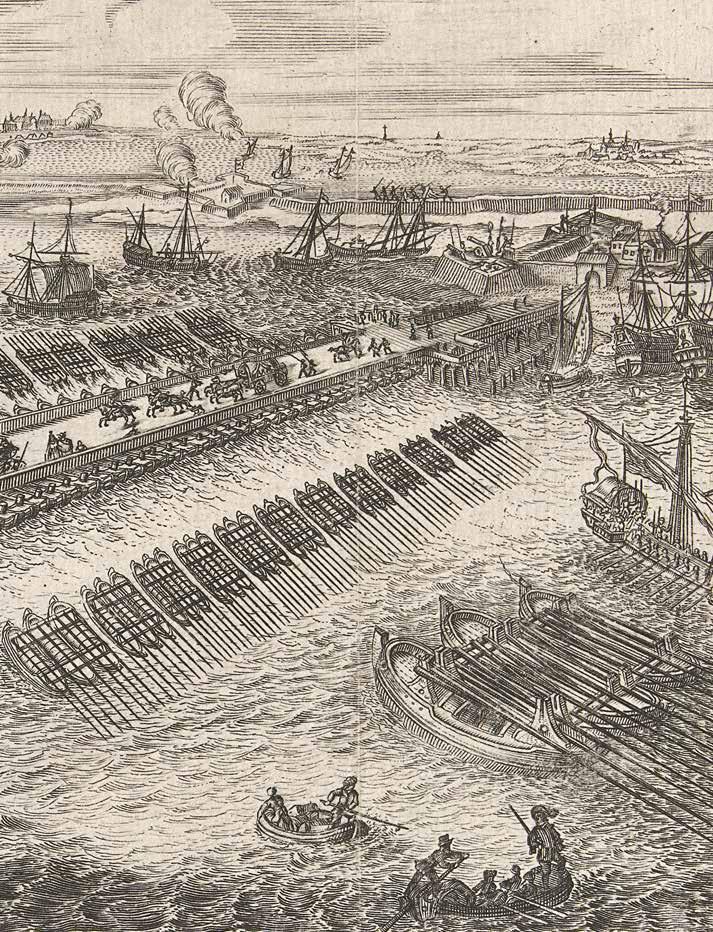
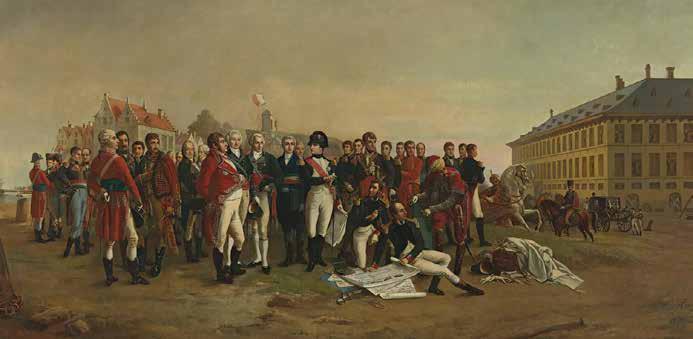
The fall of Antwerp had profound geopolitical consequences. It solidified the division of the Low Countries: the Protestant north (the Dutch Republic) became a rising maritime power, while the Catholic south (modern-day Belgium) remained under Spanish control. The Dutch, seeing Antwerp as a rival, took control of the Scheldt's estuary and closed the river to navigation, effectively strangling the port’s economic lifeline. For over two centuries, this blockade would stifle Antwerp’s commercial ambitions and elevate Amsterdam as the new economic powerhouse of the north.
Despite Napoleon's eventual defeat at Waterloo in 1815, the improvements made under French rule laid the groundwork for Antwerp’s resurgence ‘‘
Revival under revolutionary France
Antwerp’s fortunes began to shift only in the late 18th century. In 1792, during the French Revolutionary Wars, French forces occupied the city. The French saw strategic and economic value in reactivating Antwerp’s port. It was Napoleon Bonaparte who fully recognised its potential –not just as a commercial centre but as a military asset. He famously declared Antwerp to be “a pistol pointed at the heart of England” and ordered the construction of modern docks and shipbuilding facilities to turn it into a base for his naval ambitions.
Despite Napoleon's eventual defeat at Waterloo in 1815, the improvements made under French rule laid the groundwork for Antwerp’s resurgence. The Congress of Vienna awarded the Southern Netherlands, including Antwerp, to the newly
formed United Kingdom of the Netherlands. During this period, the port enjoyed a measure of growth, but this too was cut short by geopolitical events.
Toll trouble and the path to prosperity
Belgium’s independence from the Netherlands in 1830 brought fresh challenges. In response to the separation, the Dutch imposed a heavy toll on all shipping using the Scheldt to reach Antwerp – a punitive economic measure that severely hindered trade.
This state of affairs persisted for over three decades until a breakthrough came in 1863. Recognising Antwerp’s significance to international commerce, nineteen maritime nations banded together with Belgium and England to buy out the toll in a one-time collective payment. The treaty abolished the levy and opened the river to free navigation. This cooperative act marked a major turning point for the port, ushering in a period of rapid growth and modernisation.
The world wars and the strategic imperative
Despite its resurgence, Antwerp’s history remained tied to the fluctuations of European conflict. During both World Wars, the port once again found itself at the heart of military strategy.
In World War I, German forces occupied Antwerp early in the conflict, recognising its logistical importance. However, it was in World War II that the port’s strategic value was most dramatically underscored. By the fall of 1944, Allied forces had liberated the city, but the port could not be used until the Scheldt estuary was cleared of German defenses.
Pictured: Jan-Baptist Huysmans (1866) - Napoleon Giving the Plans for Docks in Antwerp in 1803
Photo: Private collection
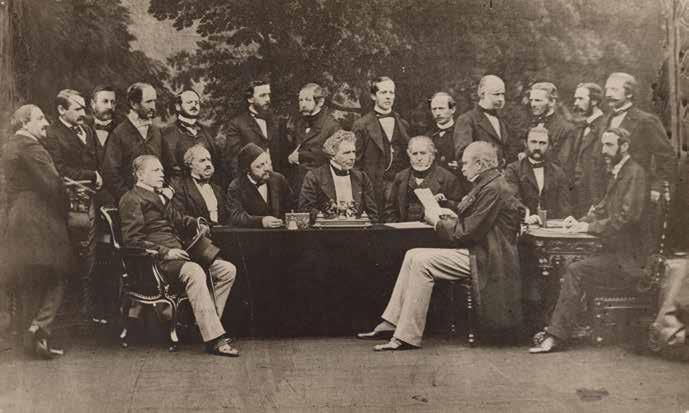
This led to the brutal Battle of the Scheldt – a series of fierce engagements in October and November 1944. Only after securing the river’s access could the Allies utilise Antwerp for their vital supply lines into Nazi-occupied Germany. The successful reopening of the port was crucial to sustaining the Allied advance, highlighting once again the port’s centrality in both commerce and war.
Lessons for the present
What the story of Antwerp illustrates is that ports are not passive backdrops to history – they are active arenas where economic ambition meets geopolitical reality. Whether choked by blockades, stifled by tolls, or transformed into
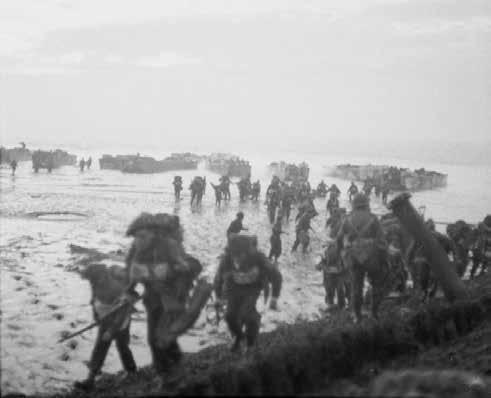
military assets, ports like Antwerp have always been sensitive to the shifting winds of power.
Today, in an age of revived great power rivalry, shipping lanes are again becoming contested spaces. The Red Sea, the South China Sea, and the Strait of Hormuz are now flashpoints that could disrupt the flow of global trade, just as the River Scheldt once was. Cyberattacks on port infrastructure, economic sanctions, and trade route diversification strategies all echo the historical forces that shaped Antwerp’s fate.
Understanding the historical resilience – and vulnerability – of ports like Antwerp offers crucial perspective. It reminds us that the current turbulence is not without precedent, and that ports, though subject to the designs of emperors and generals, also endure and adapt. ■
What the story of Antwerp illustrates is that ports are not passive backdrops to history – they are active arenas where economic ambition meets geopolitical reality
Pictured Top: Anonymous (1863) - Signatories of the Treaty on the Redemption of the Scheldt Toll
Photo: Antwerp, Felixarchief
Pictured Left: Stiggins (1944) – Royal Marines coming ashore near Vlissingen during the Battle of the Scheldt
Photo: London, Imperial War Museums
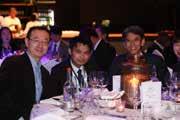
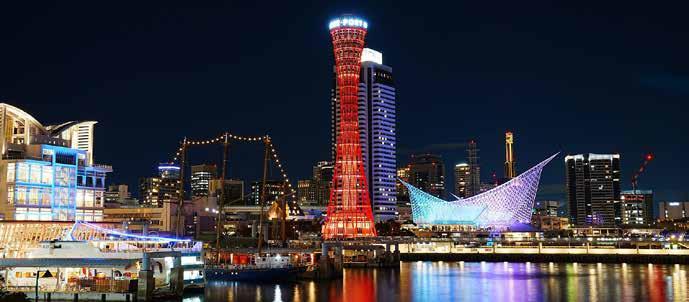
Richard Ballantyne Chief Executive
British Ports Association
Ruth Banomyong Commissioner Port Authority of Thailand
Marika Calfas CEO NSW Ports
Mar Chao President Port of Valencia
Bud Darr President & CEO
Cruise Lines International Association
Annick De Ridder Minister for Mobility, Public Works, Ports and Sport Government of Flanders
Yesim Elhan-Kayalar Adviser, Office of the Chief Economist
Asian Development Bank
Dominik Englert Senior Economist
The World Bank
Jens Eskelund Chief Representative, Greater China and Northeast Asia Maersk
Michal Forland Port Director Port of Bergen
Julie Gascon President and CEO Port of Montreal
Jonathan Goldner Regional Managing Director, Asia and Middle East
APM Terminals
Warsama Guirreh CEO
Djibouti Port Community Systems
Transport and Ports The
Marcus John Managing Director
Thomas Miller Australasia
Thomas Kazakos Secretary General International Chamber of Shipping (ICS)
Maryam Mohamed Kidere
Principal Port Security Officer
Kenya Ports Authority
Sakura Kuma Executive Officer/ Managing Director
Mitsui O.S.K.Line, Ltd/MOL (Asia Oceania) Ptd. Ltd
Claes Lindgren Global Category Manager - Logistics and Transport IKEA
Lynn Loo CEO Global Centre for Maritime Decarbonisation
Jens Meier CEO and President-elect, IAPH
Hamburg Port Authority
Edvard Molitor Head of International Public Affairs & Sustainability
Gothenburg Port Authority
Hitoshi Nagasawa Vice-President/ Chairman Japanese Shipowners' Association/Nippon Yusen Kabushiki
Kaisha (NYK Line)
Sarah
Maritime Environment and Sustainability Port of Seattle
Chin Beng Ong Chief Information Security Officer Maritime and Port Authority of Singapore
Vinícius Patel Port Administration
Director Porto do Açu
Ong Kim Pong Group CEO PSA International
Masaharu Shinohara Executive Officer
Kobe-Osaka International Port Corporation
Boudewijn Siemons CEO & COO Port of Rotterdam
Sang-keun Song President & CEO
Busan Port Authority
Stephanie Jones Stebbins
Managing Director, Maritime Division Port of Seattle
Jacques Vandermeiren CEO Port of Antwerp-Bruges
Peter Xotta President and CEO
Vancouver Fraser Port Authority
Masahide Marco Yamaguchi
Manager, Transport and Logistics Division
African Development Bank Group
Jan Hoffmann Global Lead, Maritime
World Bank
Ogier Director
CONFIRMED SPEAKERS INCLUDE:
World Ports Conference
The IAPH World Ports Conference will take place from 7th to 9th October in Kobe, Japan with a central theme of ‘Reinvention and Prosperity in Turbulent Times’. Here is a look ahead to some of the highlights
■ Reinventing Maritime Trade to Preserve Prosperity in Turbulent
Times
How can world ports and maritime trade operate prosperously amid ongoing global uncertainty? What effects might we see from proliferating tariffs, or a trade war? Are energy transition and sustainability targets – set in relatively stable times – still realistic? Industry leaders will take a global view on these topics in our plenary opener.
Tuesday 7 October | 9.45-10.30 | Plenary Room
■ IMO Net Zero Framework and Role of Ports
With no low- or zero-carbon fuel emerging as the clear frontrunner to be shipping's 'fuel of the future', most ports will need to invest in a multi-fuel zero-carbon bunkering offer to accommodate the needs of their customers. How are ports preparing for this new bunkering landscape and what investments are required, in terms of infrastructure and partnerships?
Tuesday 7 October | 11.00-11.50 | Breakout Room 1
■ Lessons from Ground Zero after the Earthquake – Kobe’s Successful Recovery
Thirty years ago, the people of the City of Kobe awoke to an earthquake that claimed thousands of lives and inflicted a complete collapse in infrastructure, communications and transport. Yet the subsequent recovery of the city, its port and trade proved remarkable. What were the success factors behind this rebound and what can other port cities learn from the experience of Kobe?
Tuesday 7 October | 11.50-12.00 | Plenary Room
■ World Peace through World Trade, World Trade through World Ports
With IAPH celebrating the 70th anniversary of its foundation, this session will reflect on the association's roots in the City of Kobe and examine what can we learn from those seven decades of unprecedented international and industrial change, in an effort to help prepare ports, shipping and the wider maritime cluster for an uncertain future.
Tuesday 7 October | 15.50-16.50 | Plenary Room
■ The Current Investment Climate for Ports – Storm Clouds with Silver Linings?
The climate for investment in ports and port infrastructure has become increasingly fragmented, varying according to geography, investment source, and the transformation of the concession model along with the operators bidding for them. What does the global investment climate look like today?
Wednesday 8 October | 9.30-10.30 | Plenary Room
■ Love thy Neighbour: Forecasting Regional Port Cooperation, Alliances and Mergers
Is your port neighbour your fiercest competitor, or your next business partner? For a long time, alliances and mergers between port authorities were exceptional but, as delegates will learn, there are now concrete examples of partnerships, and even mergers, that have resulted in both financial and competitive gains for all.
Wednesday 8 October | 14.30-15.20 | Plenary Room
■ IAPH Sustainability Awards & Gala Dinner
The highlight of #IAPH2025 is the Gala Dinner and Sustainability Awards ceremony, this year taking place in the in the beautiful ballroom of the Portopia Hotel. Celebrating the very highest quality port-sustainability projects from around the world, the Sustainability Awards is a must-attend event. The evening will include a welcome drinks reception, a sit-down Japanese-style dinner, with the Awards Ceremony commencing later in the evening. Wednesday 8 October | 18.45-22.30 | Portopia Hotel
■ Kobe Liquefied Hydrogen Receiving Terminal Visit
Located on Kobe Airport Island in the Hyogo Prefecture, HySTRA has constructed and is conducting technological demonstration tests at this receiving terminal equipped with a loading arm that can transfer -253°C liquified hydrogen as is, liquified hydrogen storage tanks and other facilities. Delegates will receive a briefing on the Hy touch Kobe and participate in a boat tour to view the terminal, including the loading arm, from the port-side.
Thursday 9 October | 11.00-13.30
Port of Newcastle
Australia
61-0434 186 754
lucas.coleman@pon.com.au
www.pon.com.au
Craig Carmody, CEO PRODEVELOP, S.L. Spain 34 661320391
As the 20th century drew to a close, IAPH turned its attention to the transformative effects of the dot-com boom and the unquantifiable risks of the Y2K problem. In June 1997, the association returned to London, England for the first time since 1965, where the Port of London Authority again hosted the event.
The opening ceremony took place at Shakespeare’s Globe Theatre; proceedings from the conference notably included a demonstration of the new home page of the first official IAPH website, as well as the introduction of the IAPH 2000 Special Task Force. The mission of this group was to ‘allow IAPH to better respond to the needs of its members at the turn of the new millennium’.
Conclusions were presented at the 1999 Conference, held in Kuala Lumpur, Malaysia and hosted by Port Klang Authority. A resolution was passed pertaining to ‘the vulnerability of the maritime transport industry to the consequences of potential Electronic Date Recognition (EDR) failures prior to, on or after 1 January, 2000’ and it was agreed to encourage implementation of the IMO’s Y2K Code of Good Practice among members.
The new IAPH website provided links to relevant Y2K sites and a webpage for ports to report any noticeable bugs as the millennium began. Thankfully, a series of identical responses was recorded by member ports as 1 Jan 2000 arrived around the world. From Auckland to Bintulu, the message was the same: no problem.
Enhancing port security
With Y2K having passed without incident for the world’s ports, IAPH looked to the new century with optimism, reflected in the playful theme of its 22nd conference: 2001: A Maritime Odyssey. Held in May, the conference returned to Montreal for the first time in three decades.
Forward-looking topics on the agenda included ‘the World Economy at the Dawn of the Third Millennium’ yet, less than four months later, any preconceptions about the future were upended by the 9/11 attacks on New York and Washington,
Solutions for a new century
Faced with the diverse challenges of the 21st century –including the Y2K problem, the aftermath of 9/11, and the threat of global warming – IAPH responded with innovative partnerships and sophisticated tools, as P&H reveals

D.C. The response from the maritime sector was swift: the IMO launched comprehensive measures to strengthen counter-terrorism efforts at sea, including amending conventions, convening specialized conferences, and establishing dedicated working groups. Ports were seen as potential areas of vulnerability and port authorities as key stakeholders.
In December 2001, a letter was sent from the IMO secretary general to his counterpart at the IAPH, requesting cooperation on counter-terrorism measures. A year later, Special Measures to Enhance Maritime Security were adopted into SOLAS with major implications for ports from July 2004 onwards, under the International Ship and Port Facility Security Code (ISPS) Code. These included security assessments for port facilities, the implementation of Port Facility Security Plans and the strengthening of port facility security, including access control and installation
of surveillance equipment.
IAPH’s support for these sweeping changes were reported at the May 2003 conference – the first ever IAPH conference to be held on the African continent. Despite the impact of SARS, the Durban event was well attended. In an age of renewed uncertainty, IAPH looked both to the future (with conference proceedings provided on CD-ROM for the first time) and to the past – as its 50th anniversary loomed.
Tools to tackle global warming
IAPH’s Golden Jubilee year began with a celebration in Tokyo on 14 January 2005. Some 400 delegates were present at the event, which commemorated the association’s milestone achievements but also provided a moment for solemn reflection on the Indian Ocean
Pictured: Dancers perform during the 2005 IAPH Conference, held in Shanghai
Earthquake and Tsunami, which took place less than a month earlier.
IAPH held its annual conference in Shanghai in May, with an agenda calling for strong infrastructure expansion and highlighting the centrality of ports to China’s goal of becoming a global trade and manufacturing hub. Green policies were also on the agenda, and this would only increase by the next edition of the conference, which returned to Houston in 2007.
As secretary general Satoshi Inoue observed in Ports & Harbors, the documentary film An Inconvenient Truth had increased awareness of the problem of global warming; ‘Ports have a responsibility to tackle global warming,’ Inoue opined, adding that ‘the way forward needs to be systematic, as a one-size-fits-all solution won’t take account of different air-pollution levels’.
For IAPH, that solution came in the form of the IAPH Tool Box for Port Clean Air Programs, a digital planning tool developed by the Port Environment Committee, chaired by Geraldine Knatz of the Port of Los Angeles. The initiative was launched at the Houston conference, alongside the unanimous adoption of a resolution on clean air programs.
From WPCI to EPI
As the 2000s ended, IAPH continued to focus on environmental care, even as the Great Recession buffeted the industry. The association launched the World Ports Climate Initiative (WPCI) in Los Angeles in late 2008. It was designed for the global port community to work together to tackle climate change via six lead

projects, including one focused on indexing all vessels calling at ports based on emission performance.
These ambitious goals were discussed at the 2009 IAPH conference, hosted by the Port Authority of Genoa in May. In an echo of the forthcoming Kobe conference, the programme focused on balancing sustainability ambitions against economic upheaval, culminating in the unanimous adoption of the Genoa

The following conference, hosted by Busan Port Authority in early May 2011, took place in the shadow of the devastating Great East Japan Earthquake two months earlier. The event saw two other critical resolutions, the first on the Safety of Containers in the Supply Chain – pressing for requirements for shippers to correctly pack and document cargo, including the mandatory accurate weighing at the origin of the shipment. The other urged members and nonmembers to join the recently established Environmental Ship Index (ESI). WPCI was making significant progress and its chair, Geraldine Knatz, was unanimously elected the 29th IAPH president. ■
Resolution urging ports to invest in productivity and tackle climate change through the WPCI.
Pictured top: The Montreal Symphony Orchestra performs in Notre-Dame Basilica during the opening ceremony of the 2001 IAPH conference
Pictured left: A baritone performs at the gala dinner of the 2009 IAPH Conference, held in the Palazzo Ducale, Genoa

BOOK AUTHOR
JAMES KRASKA is Charles H. Stockton Professor of International Maritime Law, Stockton Centre for International Law, US Naval War College. He is a retired a US Navy judge advocate.
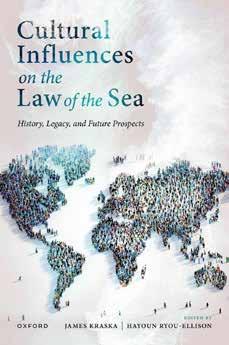

BOOK AUTHOR
HAYOUN RYOU-ELLISON is Assistant Professor, College of International Security Affairs, National Defence University in Washington DC and has taught widely at numerous prestigious institutions.
THE REVIEW
Cultural Influences on the Law of the Sea: History, Legacy, and Future Prospects
MARTIN CLARK
Cultural Influences on the Law of the Sea provides a timely and insightful exploration into how cultural traditions shape the foundations and evolution of maritime law. Far from being a culturally neutral system, the law of the sea is shown to be deeply rooted in regional ideologies, histories and philosophies. Edited by a globally representative team of scholars, this volume challenges conventional legal narratives and broadens our understanding of how diverse worldviews inform the governance of the world’s oceans.
One of the book’s key strengths lies in its comparative framework, which draws from both the global north and south. This diversity of contributors allows for a rich analysis of how various cultures interpret legal norms. For example, the Western doctrine of
‘freedom of the seas’ reflects not only legal tradition but also Western European ideals of individual liberty and geopolitical influence. In contrast, African communitarian values underpin the concept of the oceans as the ‘common heritage of mankind,’ while Latin American anti-colonial and dependency theories emphasise strong coastal state rights. East Asian legal traditions, shaped by Confucian hierarchies, place greater value on structure, order and deference to authority in maritime governance.
The book’s scope is impressively broad, covering contemporary legal challenges such as maritime security, environmental protection, deep-sea mining, sustainable development and freedom of navigation. These issues are not examined in isolation but placed within the wider cultural contexts that
influence legal interpretations and policy decisions. This interdisciplinary approach adds depth to the legal analysis and makes the volume highly relevant for scholars, legal practitioners, and policymakers alike.
Particularly notable is the book’s inclusion of perspectives from regions often marginalised in maritime legal discourse. This attention to underrepresented voices strengthens its call for a more inclusive and culturally responsive framework for ocean governance.
Drawing on evidence from the origins of civilisation to the present, its chapters offer a breadth of perspectives on major elements of the law of the sea, including marine environmental protection, marine resource conservation, sustainable development, maritime security, and freedom of navigation. ■





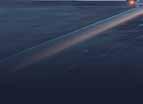


DIGITAL SOVEREIGNTY






















